
About UsThe Numismatic Bibliomania Society is a non-profit organization devoted to the study and enjoyment of numismatic literature. For more information please see our web site at coinbooks.org SubscriptionsThose wishing to become new E-Sylum subscribers (or wishing to Unsubscribe) can go to the following web page link MembershipThere is a membership application available on the web site Membership Application To join, print the application and return it with your check to the address printed on the application. Membership is only $20 to addresses in the U.S., $25 for First Class mail, and $30 elsewhere. For those without web access, write to: Terry White, Treasurer
AsylumFor Asylum mailing address changes and other membership questions, contact Terry at this email address: terrywhite5475@yahoo.com SubmissionsTo submit items for publication in The E-Sylum, just Reply to this message, or write to the Editor at this address: whomren@gmail.com BUY THE BOOK BEFORE THE COIN |
- WAYNE'S WORDS: THE E-SYLUM MAY 29, 2016
- KOLBE & FANNING SALE 142, JUNE 24-25, 2016
- NEW BOOK: A GUIDE BOOK OF LIBERTY SEATED SILVER COINS
- NEW BOOK: THE REPUBLIC ONE CENTAVO, 2ND EDITION
- BOOK: MINTING MACHINERY ON COINS AND MEDALS
- MORE ON THE DISNEY DOLLARS BOOK
- MERKIN CATALOGS AVAILABLE ON THE NEWMAN PORTAL
- THE NATIONAL COIN COLLECTORS ASSOCIATION
- NOTES FROM E-SYLUM READERS: MAY 29, 2016
- HOWARD GIBBS' QUEER KINDS OF MONEY
- ERIC P. NEWMAN (1911-PRESENT)
- OBSOLETE NUMISMATIC TERMS
- GARY BEALS: ZINC, YOU STINK!
- MONEY MUSEUM MOUNTS GOLD RUSH EXHIBIT
- ARTICLE PROFILES COIN CARVER PAUL HOLBRECHT
- THE WALTER GLENN COLLECTION OF ART-DECO MEDALS
- P. SCOTT RUBIN ON AUCTION CATALOG RESEARCH
- POEMS OF ERIC P. NEWMAN
- FEIGENBAUM PREVIEWS POGUE IV SALE LOTS
- POGUE IV SALE RESULTS
- BILL GIBBS ON THE POGUE IV SALE
- ROBERT KORVER ON POST-AUCTION PURCHASES
- SELECTIONS FROM EARLY AMERICAN JUNE 2016 SALE
- SELECTIONS FROM THE 2016 MEMPHIS WORLD PAPER MONEY SALE
- 2016 WORLD STAMP SHOW OPENS IN NEW YORK
- CCAC TO VISIT THE 2016 ANA SUMMER SEMINAR
- KING OFFA PENNY FOUND IN FIELD
- TREASURE SHIPWRECK FOUND OFF NAMIBIA
- KANSAS WILCOX COIN COLLECTION HELP SOUGHT
- MALAYSIAN COIN COLLECTORS LINE UP AGAIN
- NORTH KOREA'S SECOND-DEGREE FRIENDSHIP MEDAL
- ANTI-SEMITIC BANKNOTES
- ARTICLE HIGHLIGHTS NEW POLYMER £5 NOTES
- MAGICIAN MELTS COIN WITH HANDS
- FEATURED WEB SITE: GOBRECHT DOLLARS
Click here to access the complete archive
To comment or submit articles, reply to whomren@gmail.com
WAYNE'S WORDS: THE E-SYLUM MAY 29, 2016
New subscribers this week include: Herbert Miles. Welcome aboard! We now have 1,976 subscribers.
This week we open with a new sale announcement from KOLBE & FANNING, two new books, two old ones and a new auction catalog resource on the Newman Numismatic Portal.
Other topics this week include the National Coin Collectors Association, collectors Howard Gibbs and Eric Newman, coin engraver Paul Holbrecht, a new ANA museum exhibit, art deco medals, the Pogue IV sale, auction lot selections and a rare King Offa penny.
To learn more about the Mexican Republic one centavo series, minting machinery on coins and medals, odd and curious money, shroffing, agio, zinc, Walter Glenn, the Pogue 1821 Half Eagle, Niblo's Garden, and the Scipio Co-Operative Mercantile Institution, read on. Have a great week, everyone!
Wayne Homren
Editor, The E-Sylum
KOLBE & FANNING SALE 142, JUNE 24-25, 2016
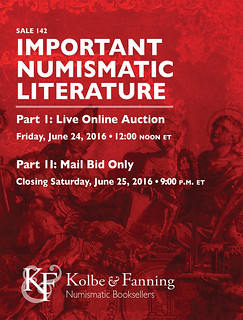 KOLBE & FANNING are pleased to announce that our 142nd sale of important numismatic literature will be held on June 24 and 25, 2016. The
two-part sale will feature a number of rare and desirable works on ancient, medieval and modern coins from several consignors. Printed catalogues are
being mailed at this time and will be arriving in the mailboxes of established clients shortly.
KOLBE & FANNING are pleased to announce that our 142nd sale of important numismatic literature will be held on June 24 and 25, 2016. The
two-part sale will feature a number of rare and desirable works on ancient, medieval and modern coins from several consignors. Printed catalogues are
being mailed at this time and will be arriving in the mailboxes of established clients shortly.
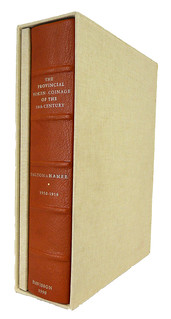 The sale is arranged in two parts. The first, featuring 380 lots, will be conducted as a live online sale on Friday, June 24. Bidders may
participate in this part of the sale in a variety of ways: in advance via mail, phone, fax or email--or on the day of the sale through our live
bidding platform at auction.numislit.com. Register in advance, browse lots and place bids at your leisure:
all lots in the first part are illustrated in the online catalogue. Live bidding will commence at noon eastern time on June 24.
The sale is arranged in two parts. The first, featuring 380 lots, will be conducted as a live online sale on Friday, June 24. Bidders may
participate in this part of the sale in a variety of ways: in advance via mail, phone, fax or email--or on the day of the sale through our live
bidding platform at auction.numislit.com. Register in advance, browse lots and place bids at your leisure:
all lots in the first part are illustrated in the online catalogue. Live bidding will commence at noon eastern time on June 24.
The second part of the sale features over 600 lots of numismatic books, periodicals and catalogues from around the world, and will be conducted as a traditional mail-bid sale (no online component). This second part of the sale will close at 9:00 pm eastern time on Saturday, June 25. Bids may be placed via mail, phone, fax or email; bids will be treated as limits and reduced as competition dictates.
Some highlights include the following:
-
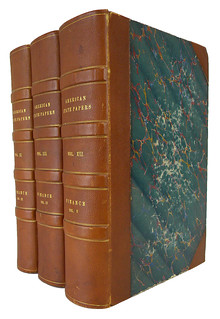 Lot 18: Barbarigo's extraordinary 1732 elephant folio Numismata virorum illustrium ex Barbadica gente, in a contemporary
armorial full red morocco binding, bound with the rare 1760 supplement
Lot 18: Barbarigo's extraordinary 1732 elephant folio Numismata virorum illustrium ex Barbadica gente, in a contemporary
armorial full red morocco binding, bound with the rare 1760 supplement
- Lot 77: an extensive run of over 250 Gerhard Hirsch sales, including the first 160
- Lot 84: a fine original copy of Imhoof-Blumer's Griechische Münzen
- Lot 113: Mouchmov's rare work on ancient coins of the Balkans
- Lot 139: the rare 1894 Sangiorgi sale of the Sossi Roman coins, with plates
- Lot 201: one of 26 copies of the 1990 Davisson edition of Dalton &Hamer bound in levant quarter morocco
- Lot 220: Jacob Hirsch's very scarce folio catalogue of the Arthur Löbbecke collection of medals
- Lot 374: a deluxe leatherbound 1996 Robinson S. Brown large cent sale, one of five copies produced
- Lot 376: three original volumes of the American State Papers on finance, containing much numismatic information.
The sale also offers, split between both sections of the sale, an extraordinary run of George F. Kolbe catalogues in hardcover format, including nearly every hardcover Kolbe sale.
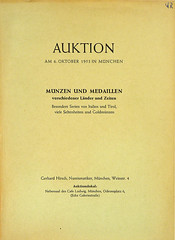
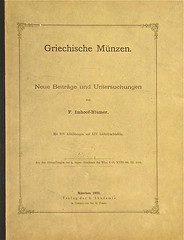
Lot 77 and 84
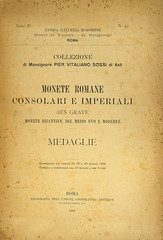
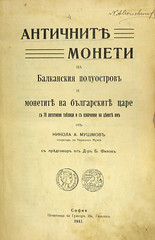
Lots 113 and 139
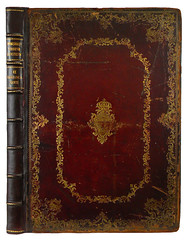
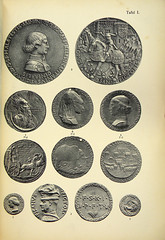
Lots 18 and 220
As mentioned above, printed catalogues are being mailed to established clients; a PDF of the catalogue has been posted to the main numislit.com website for those who prefer to read online. In addition, prospective bidders are able to access the live online catalogue and register to bid in Part I of the sale through auction.numislit.com.
KOLBE & FANNING Numismatic Booksellers LLC is a licensed and bonded auction firm in the State of Ohio. For more information, please see the KOLBE & FANNING website at numislit.com or email David Fanning at df@numislit.com. We look forward to your participation.

NEW BOOK: A GUIDE BOOK OF LIBERTY SEATED SILVER COINS
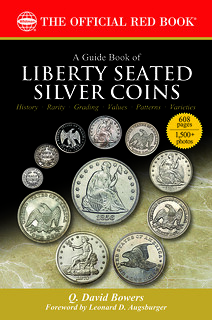 Whitman Publishing announces the release of A Guide Book of Liberty Seated Silver Coins, by Q. David Bowers. The 608-page book
(number 21 in the popular Bowers Series) is available from booksellers and hobby shops nationwide, and online (including at www.Whitman.com), for
$29.95.
Whitman Publishing announces the release of A Guide Book of Liberty Seated Silver Coins, by Q. David Bowers. The 608-page book
(number 21 in the popular Bowers Series) is available from booksellers and hobby shops nationwide, and online (including at www.Whitman.com), for
$29.95.
Coins with the Liberty Seated design were minted from 1836 up to 1891. The motif was used on circulating half dimes, dimes, quarters, half dollars, and silver dollars, in addition to twenty-cent pieces, Gobrecht dollars, and, in modified form, U.S. trade dollars. The mints at Philadelphia, New Orleans, Carson City, and San Francisco were used to produce tens of millions of these coins. They were minted from the Hard Times Era through the nation's gold and silver rushes, the Civil War and its aftermath, and well into America's Gilded Age.
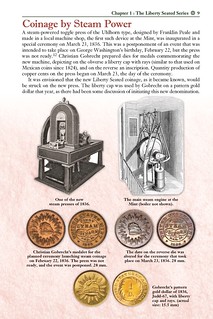 Today Liberty Seated coins are growing in popularity among U.S. coinage series, with many enthusiastic collectors and students. The Liberty
Seated Collectors Club is among the hobby's fastest-growing specialty groups. Leonard Augsburger, vice president of the club, who wrote the
Guide Book's foreword, stated that “Q. David Bowers offers both beginning and experienced numismatists a fresh perspective on
collecting these fascinating silver coins.”
Today Liberty Seated coins are growing in popularity among U.S. coinage series, with many enthusiastic collectors and students. The Liberty
Seated Collectors Club is among the hobby's fastest-growing specialty groups. Leonard Augsburger, vice president of the club, who wrote the
Guide Book's foreword, stated that “Q. David Bowers offers both beginning and experienced numismatists a fresh perspective on
collecting these fascinating silver coins.”
Author Bowers provides colorful historical context for the coins, commenting on the American scene (and the state of numismatics) from 1836 to 1891. Then he covers all eight denominations that carried the Liberty Seated design, with a coin-by-coin catalog of more than 750 entries. Bowers discusses mintages, grading standards, auction records, keys to building a high-quality collection, and other factors important to collectors and investors. He describes each coin's availability in Mint State and in circulated grades; characteristics of striking; pattern coins for each denomination; production, release, and distribution; branch-mint coinage; Proofs; die varieties; shipwreck finds; conservation; and more. The book is illustrated with more than 1,500 images.
Appendices include a chronology of coin designer Christian Gobrecht; an overview of the mints used to strike Liberty Seated coins; Mint directors and superintendents of the era; an account of a visit to the Philadelphia Mint in 1861; chief coiner Franklin Peale's description of die making in 1855; a study of master dies and hubs by professional numismatist John Dannreuther; a look at alternative U.S. currency formats of the 1800s (Postage Currency, Standard Silver, and goloid dollars); and a catalog of die and hub trials and splashers, based on the work of Saul Teichman.
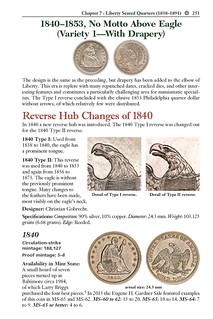
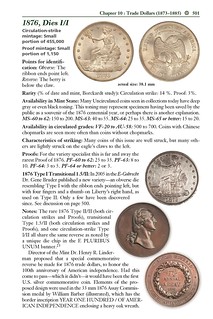
Because Whitman Publishing is the Official Supplier of the American Numismatic Association, ANA members receive 10% off the book when purchasing directly from the publisher. It can also be borrowed for free as a benefit of ANA membership, through the Dwight N. Manley Numismatic Library.
A Guide Book of Liberty Seated Silver Coins
By Q. David Bowers; foreword by Leonard D. Augsburger
ISBN 0794843832
6 x 9 inches
softcover
608 pages
full color
Retail $29.95 U.S
For more information, or to order, see:
A Guide Book of Liberty
Seated Silver Coins (www.whitman.com/store/Inventory/Detail/A-Guide-Book-of-Liberty-Seated-Silver-Coins+0794843832)
NEW BOOK: THE REPUBLIC ONE CENTAVO, 2ND EDITION
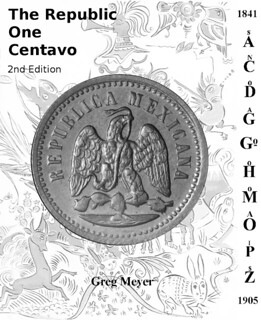 History and identification guide for the Mexican Republic one centavo series. Spans the years 1841 to 1905. 232 pages. Profusely
illustrated with closeups of the coins. Updated with over 40 new coin varieties and findings on the series.
History and identification guide for the Mexican Republic one centavo series. Spans the years 1841 to 1905. 232 pages. Profusely
illustrated with closeups of the coins. Updated with over 40 new coin varieties and findings on the series.
Greg adds:
It is $40 for the ebook. Perfect bound softcover should be out this weekend and a Hardback Color photograph edition is in the works for later this summer.
For more information, or to order, see:
The Republic One Centavo
(www.lulu.com/shop/greg-meyer/the-republic-one-centavo/ebook/product-22712946.html)
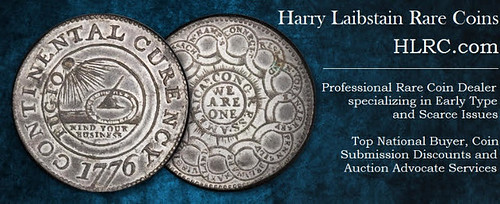
BOOK: MINTING MACHINERY ON COINS AND MEDALS
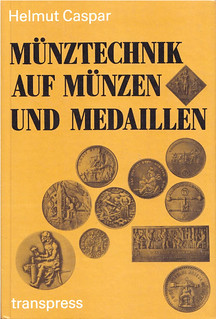 Regarding John Roberts’ comment on not knowing any reference covering coins and medals depicting minting machinery, I know of one, but it’s
in German and not very authoritative (nor up-to-date). I still welcome him to write such a book in English.
Regarding John Roberts’ comment on not knowing any reference covering coins and medals depicting minting machinery, I know of one, but it’s
in German and not very authoritative (nor up-to-date). I still welcome him to write such a book in English.
“Münztechnik auf Münzen und Medaillen” by Helmut Caspar, Berlin 1984.
Here's one copy currently for sale, but they are commonly available in Germany: www.ma-shops.com/stollhoff/item.php5?id=6166&lang=en&curr=USDEUR.
To read the earlier E-Sylum article, see:
MEDALS WITH IMAGES OF COINING (www.coinbooks.org/E-Sylum_v19n21a20.html)
MORE ON THE DISNEY DOLLARS BOOK
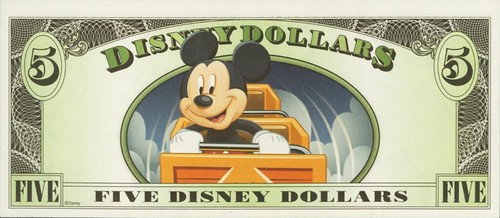
David Schwager writes:
Hello, in the May 22 E-Sylum, article "History of Disney Dollars," you mentioned that it would be nice to see someone update the book through the last series issued this year. Charles Rodgers (spelled with a "d") issued a 2014 edition of his catalog, although few were sold before he died that year. Some Disney collectors do not know of its existence, and a Heritage lot states that the Rodgers book ends in 2009.
I bought mine from blackmountaincoins.com and see that they have two copies left. $45 plus shipping is high for this short, crudely printed book, but it remains the essential reference in the field.
Many thanks for all of your work each week. I copied the May 22 issue into Word and it ran 102 pages. This is an extraordinary achievement for one man.
To read the complete Heritage lot description, see: Disney Dollar $5 2014 Rodgers R-UNL. (http://currency.ha.com/itm/miscellaneous/disney-dollar-5-2014-rodgers-r-unl/a/141612-84142.s?ic4=ListView-ShortDescription-071515)
A Coin World article by Arthur L. Friedberg noted something I'd not been aware of - Disney Dollars have been graded by one of the third-party grading services. -Editor
The Disney notes became a collectible soon after they became a currency. They were conceived by Disneyland's first president, Jack Lindquist, with images of Mickey Mouse, Donald Duck, Goofy and Pluto, as well as park landmarks, and it was apparent immediately that not all would be redeemed, but many would instead be retained as souvenirs and collectibles. They were a hit from the start, with reports of transactions as high as $10,000. The notes exist in denominations of $1, $5, $10, $20 and $50.
PCGS Currency has graded more than 20,000 Disney Dollars in the past few years. Laura Kessler, the grading company's vice president, says that they have become one of the most competitive and popular categories in the PCGS Currency Set Registry program. She was surprised by the decision, since Disney Dollars are more popular than ever among collectors, and the Disney Dollars held by collectors and not used create almost pure profit for the company that reported a net income of $8.38 billion for the 2015 fiscal year.
To read the complete article, see:
Disney Dollars
series discontinued May 14 as digital money use rises
(www.coinworld.com/news/paper-money/2016/05/disney-dollars-abruptly-canceled-but-collectors-still-enjoy.html)
To read the earlier E-Sylum articles, see:
DISNEY DOLLARS DISCONTINUED (www.coinbooks.org/E-Sylum_v19n20a22.html)
THE HISTORY OF DISNEY DOLLARS (www.coinbooks.org/E-Sylum_v19n21a13.html)

MERKIN CATALOGS AVAILABLE ON THE NEWMAN PORTAL
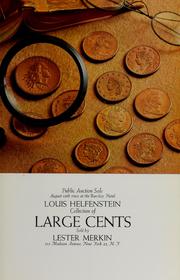 The New York dealer Lester Merkin conducted 31 sales between 1964 and 1976, and these auction catalogs are now available on the Newman
Portal. Merkin's premier sale, presenting the Louis Helfenstein large cents, is notable for the use of color photography on the catalog cover. Merkin
was obviously intending to make a splash, and, considering the importance of the consignment, succeeded nicely.
The New York dealer Lester Merkin conducted 31 sales between 1964 and 1976, and these auction catalogs are now available on the Newman
Portal. Merkin's premier sale, presenting the Louis Helfenstein large cents, is notable for the use of color photography on the catalog cover. Merkin
was obviously intending to make a splash, and, considering the importance of the consignment, succeeded nicely.
Walter Breen catalogued for Merkin during this period and the material quality is strong. Halftone plates, typical of the era, are not ideal for pedigree purposes, but the overall presentation is solid, and more than a few numismatic tidbits will be gleaned from this important run of catalogs.
Link to Lester Merkin auction catalogs on the Newman Portal:
https://nnp.wustl.edu/library/auctioncompanydetail/24
THE NATIONAL COIN COLLECTORS ASSOCIATION
I knew Bill Atkinson casually at the time the organization was formed (May 31, 1990), and we corresponded a bit about the merits of such an organization. There existed a certain uneasiness with the ANA, particularly after ANACS (then still owned by the ANA) began certifying coins in its own encapsulations in 1989. This was seen by some as selling out to the marketplace, though it was really just an eleventh hour attempt to regain its lost market share in the certification business. The old photo certificates had been a hot commodity from 1979-86, but the arrival of PCGS and NGC quickly rendered them nearly worthless.
Bill's idea was that the ANA had become too big and businesslike and no longer represented the interests of ordinary coin collectors. The NCCA was formed with the express goal of focusing on "unencapsulated pre-1965 U. S. coins with a value of less than $500." I sympathized with his concerns, but I did not accept them as fact. I wished him well but declined to join the NCCA.
I discussed this viewpoint with other figures in the hobby, with the result that I was recruited by Numismatic News to write the "No" perspective in a point-counterpoint examination of the topic titled "Do We Need a New Collector Organization?" Obviously, Bill authored the "Yes" viewpoint, and this article ran in the August 21, 1990 issue. I defended the ANA's role in providing for collectors as well as dealers, ending my commentary with this observation: "Were it not for a conflict of interest with the NCCA, Bill Atkinson would be a good candidate for the ANA's board of governors. With a knowledge of the hobby and a sincere desire to meet the expectations of collectors, he would have my vote."
Termination of the NCCA was announced by Bill in January, 1992. He noted that his club had grown rapidly in its first year to 330 members, but that after that time "defections were more common than new members." He also noted that until the club's demise the NCCA's newsletter, The U. S. Coin Collector, had been issued every two months, so there must have been about seven or eight issues. Also published by the NCCA were three monographs about United States coins, but the titles were not provided in that article. Bill then added that the NCCA Library, which had been launched the previous September, had not received even a single request to use its lending service.
To read the earlier E-Sylum article, see:
QUERY: THE NATIONAL COIN COLLECTORS ASSOCIATION
(www.coinbooks.org/E-Sylum_v19n21a10.html)
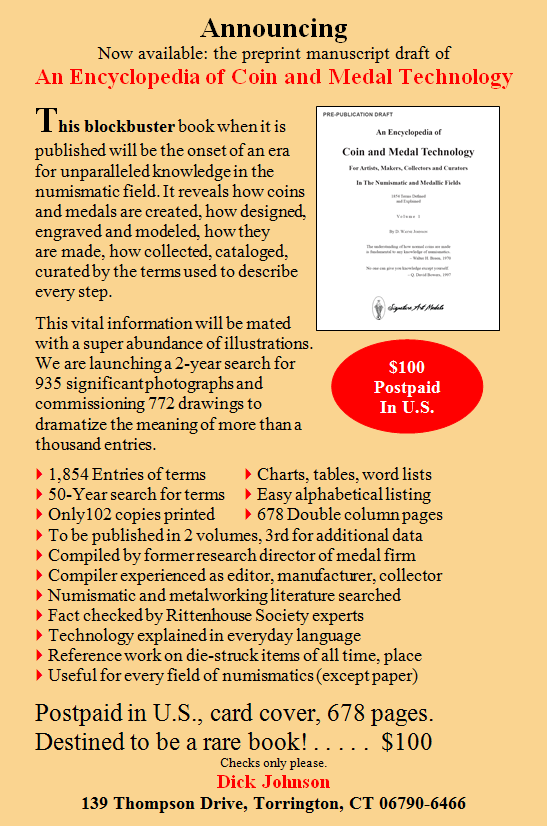
NOTES FROM E-SYLUM READERS: MAY 29, 2016
Query: Auction Catalogs Sought
Bruce Smith writes:
Some readers have written in offering to give away old auction catalogs. I have gone through my library and made a list of auction catalogs I am missing, mostly sales in Hong Kong and Singapore. If anyone has any of these and would like to dispose of them, please let me know:
Money Company #20 June 1988;
Spink-Taisei-Baldwin-Ma
- #2 Feb. 1987;
- #5 July 1987;
- #7 July 1989;
- #9 Feb. 1991;
- #41-44,
- #46;
- #48-50
Also need all Spink Hong Kong sales after 1995 (coins and banknotes only). I will be happy to pay postage.
Serial Numbering on National Bank Notes
Joe Boling submitted the following as a Letter to the Editor of The Numismatist regarding a statement in an article that was also
published here in The E-Sylum last week.
In the May issue of The Numismatist (page 27), Jennie K Brown and Ray O’Shinski discuss O’Shinski's Castle Shannon $20 national bank note, serial number F000014A. They say that this was the 14th note printed for the bank in that series and denomination. This is not correct.
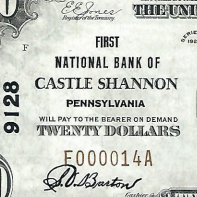 There were two varieties of series 1929 nationals - those with the bank charter number printed twice in black (type I, O’Shinski's note),
and later ones with the charter number twice in black and twice again in brown (type II).
There were two varieties of series 1929 nationals - those with the bank charter number printed twice in black (type I, O’Shinski's note),
and later ones with the charter number twice in black and twice again in brown (type II).
It was only the type II notes that were numbered down the sheet in sequential order. Type I notes were numbered by the sheet, with the serial number prefix indicating the position of a note on the six-note sheet. Serial number F000014A was the bottom note of the 14th sheet - thus the 84th note of this series and denomination.
To read the earlier E-Sylum article, see:
THE CASTLE SHANNON BANK ROBBERY (www.coinbooks.org/E-Sylum_v19n21a21.html)
Dead Presidents At the Theatre
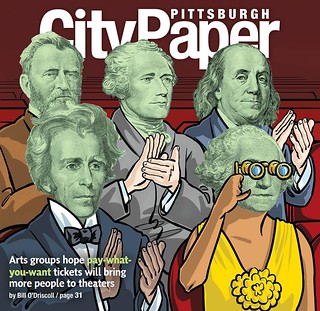
Pat McBride writes:
This is the cover of the Pittsburgh City Paper this week. It is somewhat unique to see a numismatic tie in for use in the non-numismatic press. Those old boys caught my eye as I passed the news box. I grabbed a few extra copies to hand out to our PAN Board Members at our meeting next week.
Quick Quiz: A Mystery Numismatist
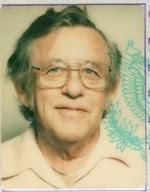
Query: Counterstamped New Jersey Cent Information Sought
Bruce Smith writes:
I know The E-Sylum has several specialists in early U.S. coppers, so I thought I would pose this question here. Last week I was called in to look through a large collection of Chinese coins --- over 5,000 pieces. In the collection we also found several dozen United States tokens (mostly Civil War) and one U.S. coin (a 1916 Buffalo nickel about 35 percent off center).
Also in the collection were three New Jersey coppers of the 1780's, one of which was counterstamped: S S (in large letters). Is this a recorded counterstamp on this coin? If so, has it been identified? The New Jersey coppers were all well worn and the counterstamp is definitely old. The collector who formed this collection died in 1970 and the collection has been in storage since then
Norweb Mansion for Rent
Stephen Searle writes:
Here's a strange one. In case any of your readers are attending the Republican National Convention in Cleveland this July, they could add in a little numismatic connection by renting the old Holden/Norweb mansion (third floor maids quarters only) for the week.
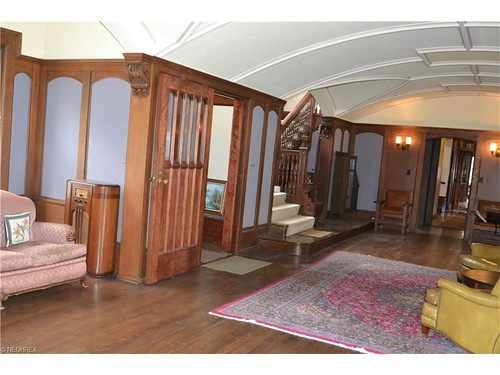
To read the complete listing (and view more photos), see:
http://www.rmxlakerealty.com/Web/AR704241/ListingSearch/details/?mls_id=OH-NORMLS&mls_no=3797200&display_page=1&lpp=20&total_listings=459
&ss_id=5471501&from=saved_search
Collecting Zero Rupee Notes
Stephen Searle writes:
Regarding the Zero Rupee note, how ironic that it could become a collectible, generate demand, and gain “value.” Should this happen, it would have the opposite of the intended effect.
To read the earlier E-Sylum article, see:
THE ZERO RUPEE ANTI-CORRUPTION NOTE
(www.coinbooks.org/E-Sylum_v19n21a36.html)
No Henry VIII Beard Tokens
Robert Thompson writes:
Neither have I: Palgrave's Dictionary of Political Economy is wide-ranging and often helpful, but seems not to cover taxation of beards!
To read the earlier E-Sylum article, see:
U.K. BARBER CALLS FOR TAX ON BEARDS
(www.coinbooks.org/E-Sylum_v19n21a42.html)

THE BOOK BAZARRE
HOWARD GIBBS' QUEER KINDS OF MONEY
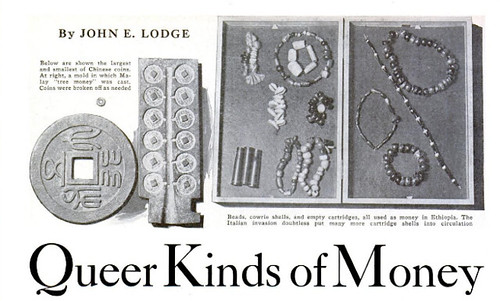
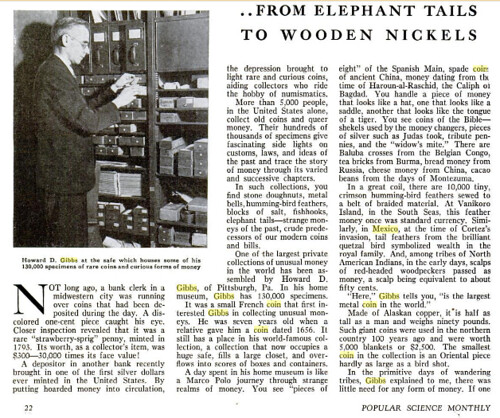
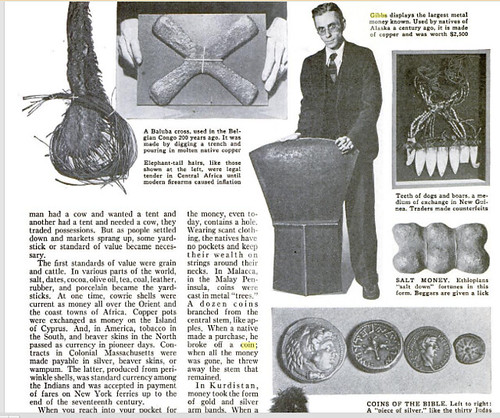
1936 Popular Science article
To view the complete album, see:
www.flickr.com/photos/coinbooks/albums/72157668470927592
ERIC P. NEWMAN (1911-PRESENT)
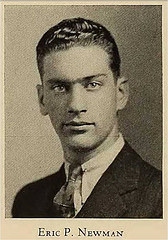 Eric P. Newman (1911-Present) was born at St. Louis, Missouri on May 25, 1911, son of Dr. Samuel Elijah Newman and his wife Rose Pfeiffer.
He attended college at M.I.T. and graduated with a B.S. in 1932.
Eric P. Newman (1911-Present) was born at St. Louis, Missouri on May 25, 1911, son of Dr. Samuel Elijah Newman and his wife Rose Pfeiffer.
He attended college at M.I.T. and graduated with a B.S. in 1932.
In 1935, he graduated with a J.D. from Washington University, St. Louis, Missouri, and that August passed the bar exam. In 1939, the year of the New York World's Fair, he advanced as a collector and was named Secretary of the Central States Numismatic Society. That same year he married his wife Evelyn, and they have two children, Linda N. Schapiro and Andrew E. Newman.
He practiced law from 1935 to 1943 when he entered the corporate world working for Harry Edison, president of Edison Brothers Stores, Inc., Atlanta, Georgia. In 1968 he was promoted from Treasurer to Executive Vice President and Secretary of Edison Brothers Stores, Inc., St. Louis, Missouri. He retired from corporate life in 1987, and approaching his 30th anniversary of retirement. And the best is yet to come!
Numismatic Career
Eric Newman has enjoyed one of the longest and most colorful numismatic careers in American history. He is loved by countless collectors
who have enjoyed reading his well researched articles and books on numismatics which spans 75 years in 2016. That's longer than the
Chapman Coin Dealing Dynasty (1875-1948). Among the numerous anecdotes are such stories as the time B. Max Mehl asked him to be a shill
bidder in one of his auctions, and the moral giant of integrity Newman flat out told him, "No!"
He began collecting coins at the age of five in 1916 the same year the St. Louis Numismatic Society (founded October 1915) joined the ANS. It was when grandpa Pfeiffer gave him an 1859 Indian Head copper-nickel cent. At the time the coin was fifty-seven years old. Today it is one hundred and fifty seven years old. In other words, Eric Newman has been collecting coins for a whole century now and didn't even start with a red cent, it was gray.
He entered the coin world in his youth when at age ten he befriended Burdette G. Johnson, the second owner of St. Louis Stamp and Coin Company, St. Louis Missouri in 1921. He applied for membership in the ANA in December 1934, and in January 1935 was given ANA Member No. 4624. On February 15, 1938 Newman is among the founders of the Missouri Numismatic Society and is elected first Vice-President.
During the 1940's together with Burdette G. Johnson (1885-1947), Newman acquired a large portion of the Colonel Edward Howland Robinson Green (1868-1936) coin collection.
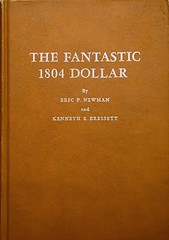
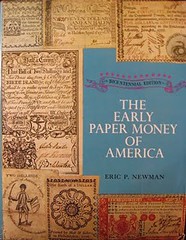
In 1962 he co-authored with Ken Bressett, The Fantastic 1804 Dollar. In 1967, he published The Early Paper Money of America, which is now in its 5th edition, with a 6th edition forthcoming. Also in 1967 Eric Newman mastered the thorny subject of cleaning coins giving a whole new meaning to the phrase and simultaneously also to another "How to pick a coin."
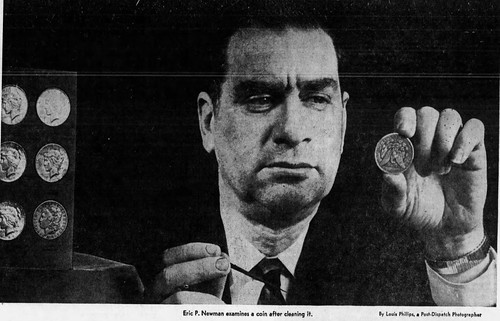
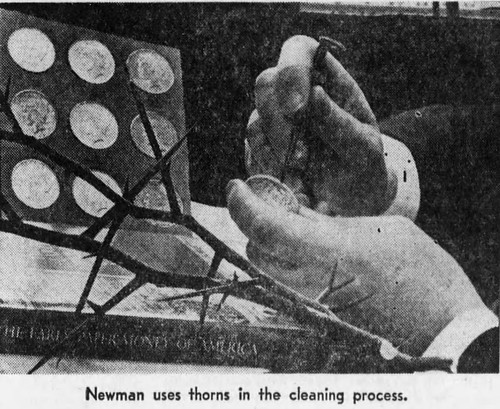
St. Louis Dispatch, Sunday 26 March 1967, page 99
May 25, 2016, Happy 105th Birthday!
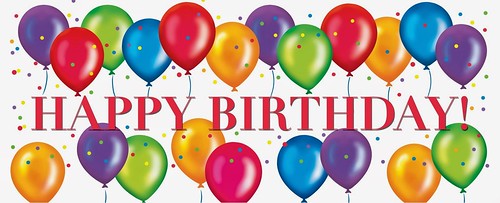
And if you should survive to 105
Think of all you derive
out of being alive
And here is the best part
You've had a head start
If you are among the very
Young at Heart!
Happy Birthday Eric!
To read the complete article, see:
NEWMAN, ERIC PFEIFFER
(https://sites.google.com/a/numismaticmall.com/www/numismaticmall-com/newman-eric-p)
To order a copy of Eric's biography Truth Seeker, see: http://coins.ha.com/itm/books/truth-seeker-the-life-of-eric-p-newmanres/i/960011799.s

OBSOLETE NUMISMATIC TERMS
We are fortunate editor Wayne Homren in last week's issue included illustrations and descriptions of five gold coins from a recent Stacks-Bowers auction. These rare coins were called “Regulated” -- a rare occurrence in early American Colonial times. Not all numismatists might know this term; it is an accurate term for an obscure practice.
I faced a decision with many obscure terms. Should they be included in my Encyclopedia of Coin and Medal Technology? Absolutely! Such terms are just what many readers would look for in an encyclopedia. Here is my entry on regulated gold:
Regulated Gold. In Colonial American era a practice of identifying full weight of a gold coin by counterstamp of a private firm. The custom was short lived and existing coins with such a COUNTERSTAMP are exceedingly rare. The famed New York goldsmith Ephraim Brasher placed his EG initial PUNCH mark on gold coins he guaranteed weight. While this is observed only on gold coins, the practice is somewhat comparable to CHOP MARKS in the Orient where it was more prevalent on silver coins. See SHROFF. CLASS 10.9
Words in SMALL CAPS refer to entries in the Encyclopedia, as the case here referring to another obscure term SHROFF (enteries on counterstamp and punch are quite lengthy):
Shroff. To sort circulating silver coins in trade according to fineness by banks and merchants in the Orient. The term is both the verb for the act – also called shroffing – and the employee who does the testing. He sorts out spurious coin, notes debased coins and marks acceptable standard coins with a CHOP MARK (also called shroff mark). He marks acceptable coins with a PUNCH containing his bank's or merchant's symbol. Coins rapidly became heavily chop marked after many transactions. See CHOP MARK. CLASS 10.9
Another term for full value of a coin determined by its weight at the time of a transaction is AGIO.
Agio. A deduction from the face value of a precious metal coin because it is worn. When the bullion value of a coin was not near the face value, worn coins of precious metal (prior 1920) were occasionally discounted, If a coin appeared worn it would be weighed. The current value or transaction value would be discounted a small percentage based on the amount of short weight. Reference: NE12 (1917) Frey, p 4. CLASS 14
Occasionally references are made to other books listed in the Bibliography for further information, as is the case here in reference to Albert Frey's Dictionary of Numismatic Names.
These terms are all concerned with coins when they had value, made of precious metals. This in contrast to today's token coins, all of low-value alloys. Imagine having to weigh your coins at every transaction today! Thankfully weighing coins is no longer necessary, as are COIN SCALES – but that's another entry!
To read the earlier E-Sylum article, see:
REGULATED GOLD: STACKS'S BOWERS MAY 25, 2016 SALE
(www.coinbooks.org/E-Sylum_v19n21a24.html)
GARY BEALS: ZINC, YOU STINK!
The article in last week issue reminded me how much our government is suckered by the zinc industry while citizens waste their time with cents. Let's take a closer look at zinc in coins The article began:
Most people know that pennies cost the government more to make than they're worth, even after the U.S. Mint switched to using mostly zinc in 1982. They may not know that making all those pennies has a serious environmental impact, from raw ore, to smelter, to mint, and then to banks before finally being dropped on the street or dumped into a coin kiosk or a fountain.
Zinc is the cheap grey metal that is the material of choice when a government looks to make a near valueless coin. The thought of not making a coin so valueless does not seem to enter the minds of governmental leaders worldwide.
These coins are the Kardashian sisters of monetary systems. They all look appealing at the first glance, we see them everywhere, but then we realize there is no substance below the shiny surface. You can even dissolve the zinc out of a USA cent leaving a fragile copper shell — what fun!
Three coins in the fountain? They better not be zinc under that thin copper plating — they begin corroding in 48 hours —fouling the water. And many banks refuse to accept corroded coins at full face value.
The zinc coated steel cents of 1943 were ugly once that zinc hit the air. Zinc deteriorates into chalking or white rust – zinc oxide might belong on a surfer's nose but as 97.5% of one of my coins? No thanks.
Sacrifice Zinc! Zinc is best used as a sacrificial metal in our oceans. Really. Ships sail with slabs of zinc bolted to their hulls so that the salt water will dissolve it rather than steel and bronze of the hull and propellers. Blocks of zinc are also attached to oil rig pipes under water. Sacrificial anodes of zinc attract the corrosion that would otherwise rust the iron/steel. The sacrificial anodes must be replaced periodically as they corrode.
Now, if we could only get the Kardashian sisters to sacrifice themselves to protect much greater show business talent we will really be on to something, but I digress.
The cent's alloy remained 95 percent copper and 5 percent zinc until 1982, when the composition was changed to 97.5 percent zinc and 2.5 percent copper (copper-plated zinc).
Zinc, you may help in some men's prostate problems but you have no business in anybody's coins unless you are mixed with 10 times more than your weight of copper — now you are part of brass and bronze.
Canada ended its use of the cent in 2012. Shortly thereafter, the group Americans for Common Cents (ACC) a disguised zinc lobby organization, declared that most Americans want to keep the cent.
“Penny Still Makes Sense to Most Americans,” according to the San Diego Union-Tribune, which described the ACC's press release as a “report” and described the ACC as “a consortium of 50 groups that are working to highlight the benefits the penny provides to the economy and consumers.” “Only Some Americans Want to Cut The Coin.” Was another headline back then. Boy, how some journalists get suckered by flacks.
So — horse pucky. ACC is run by the main lobbyist representing the zinc industry, which supplies most of the metal used in pennies. Turns out, the group was citing opinion polls from 15 to 25 years ago. The most recent was conducted in 2006 — by Coinstar makers of vending machines that turn coins into currency. According to the ACC using a very old study, two-thirds of Americans want to keep the penny. That's the number several media outlets cited in their accounts of the “new report.”
It costs 2.4 cents to make each cent. That might be OK if the coins were useful, but they’re not.
On the flip-side we who watch coin collectors can marvel at the marketing prowess of the USA and European Union government. They can turn out ‘commerative’ dollar and euro-value coins for about 18 cents each, and people snatch them up and toss them in their dresser drawers. Presto — easy money made off people looking for all the states, or all the national parks or all the presidents.
Faced with the stark financial facts, any sentimental attachment to the cent might fade. FORTUNE Magazine reported in 2012:
Beside national inertia, the main reason the penny is still here is that business interests want it that way. President Obama, when he was campaigning in 2008, said he would like to get rid of the cent. “I need to find out who is lobbying to keep the penny,” he said. The Center for Responsive Politics, which tracks lobbyists knows, it's Big Zinc and the vending industry are the powerful penny lobby. We don’t know how hard the president fought on that battle, but we lost.”
One firm, Jarden Zinc, spends about $140,000 a year for pro-penny lobbying services, and, as an example, in 2011 was awarded $48 million in federal contracts.
An Internet article on cleaning zinc provides gloomy news: Zinc was used for coinage only in emergencies and only for coins destined to have a short period of circulation. For example, zinc money occurs principally in many emergency coinages of German cities after the First World War and also in the small change of the Third Reich from 1940.”
It must be assumed that the raw material available was not always satisfactory. Zinc contains traces of lead, bismuth and iron. These impurities cause zinc coins to vary in behavior with chemicals.
The provided methods that can be used for cleaning zinc coins, none of which were considered completely satisfactory. One cleaning example:
“Immersion into Sulfuric Acid (H2SO4) Solution. The best and simplest method of removing grayish-white zinc oxidation is placing the coins in approximately 5% Sulfuric acid (diluted 1:20) and leaving them there for 10 to 20 minutes. Caution: dilution of sulfuric acid must always be done by pouring acid into water in a fine stream, never by pouring water into concentrated sulfuric acid! Neutralization is accomplished by immersion in 5% Sodium Hydroxide (caution: caustic soda) and rinsed thoroughly. They are then brushed.”
So clean them up and you are all set? No, your work with zinc coins is not done:
“Zinc coins must be protected unconditionally from the effect of the atmosphere and its constituents, or they will darken again in a short time (a few weeks). This is best done by lacquering with Japanese lacquer. An oil film can be provided by kerosene or Ballistol.”
To read the earlier E-Sylum article, see:
HOW GREEN IS THE U.S. CENT? (www.coinbooks.org/E-Sylum_v19n21a17.html)
MONEY MUSEUM MOUNTS GOLD RUSH EXHIBIT
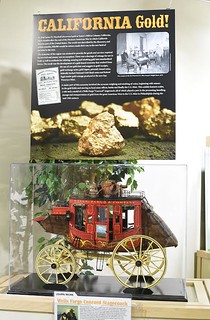 The Edward C. Rochette Money Museum, operated by the American Numismatic Association in Colorado Springs, has unveiled an expansion of its
“Gold Rush” exhibit, which currently highlights Colorado mining history with displays of Clark Gruber &Co. territorial gold coins and Lesher
dollars.
The Edward C. Rochette Money Museum, operated by the American Numismatic Association in Colorado Springs, has unveiled an expansion of its
“Gold Rush” exhibit, which currently highlights Colorado mining history with displays of Clark Gruber &Co. territorial gold coins and Lesher
dollars.
The permanent exhibit now showcases the California Gold Rush as seen through the instruments that were essential for processing bullion—scales and weights. The exhibit was made possible through a donation from the Gerard A. Smith Collection.
Notable instruments on display include a giant scale used at the Denver Mint, as well as handheld scales used by miners and prospectors in the gold fields. Also on display is a scale model replica of a Wells Fargo “Concord” stagecoach. First introduced in 1827, the Concord stagecoach was designed for freight and passenger service; Wells Fargo adopted the Concord for its passenger, mail and bullion service in 1852.
“Donations of this type help to make the ANA's educational mission possible and enables the Money Museum to enhance exhibits by illustrating the history of our country through numismatic objects,” said Doug Mudd, the Money Museum's curator and director.
Rush For Riches
The California Gold Rush began in 1848 with James Wilson Marshall's historic find at Sutter's Mill in Coloma, Calif. The world became
electrified as rumors of a gold discovery spread; within months, 300,000 potential miners stampeded west to the new promised land of
mineral riches.
The balance (also known as the balance scale, beam balance or laboratory balance) was the first mass measuring instrument invented. Scales have been used in the U.S. since the colonial period to weigh coins, accurately calculate their value and detect counterfeits. Scales were also essential to miners.
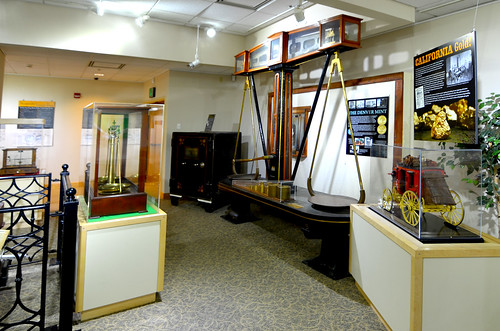
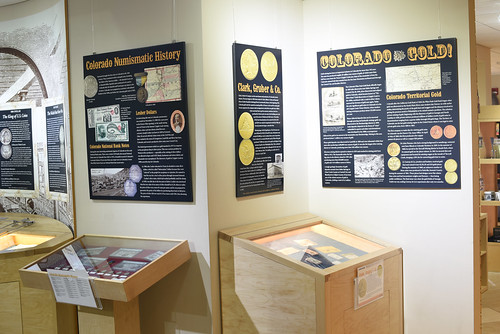
Lesher-Guber Cases
Money Museum Background
The Money Museum includes an extensive and ever-growing collection of historical numismatic treasures. This one-of-a-kind facility
showcases some of the most valuable and significant numismatic items the public cannot see anywhere else. Rarities include a 1913 Liberty
Head nickel valued at $2 million and two of the 15 known 1804 dollars valued together at $6 million.
For more information, see:
https://www.money.org/money-museum/
THE BOOK BAZARRE
ARTICLE PROFILES COIN CARVER PAUL HOLBRECHT
 In this issue we travel across the ocean to meet with Paul Holbrecht in Belgium. He has been carving since 2008 and started with homemade
gravers. In 2013 he upgraded to professional tools and a microscope (AmScope 10X-30X) and soon followed up with his first hobo nickel sale on eBay.
He also uses magnification in the form of an optivisor to draw his designs on nickels and to sharpen his tools. So far he estimates having made
roughly sixty or more carvings.
In this issue we travel across the ocean to meet with Paul Holbrecht in Belgium. He has been carving since 2008 and started with homemade
gravers. In 2013 he upgraded to professional tools and a microscope (AmScope 10X-30X) and soon followed up with his first hobo nickel sale on eBay.
He also uses magnification in the form of an optivisor to draw his designs on nickels and to sharpen his tools. So far he estimates having made
roughly sixty or more carvings.
Holbrecht is one of those people that was perhaps born an artist. Since early childhood he was interested in drawing with either pencil or ink. Holbrecht also had a penchant for taking things apart to see how they worked and taught himself how to repair things. He believed he could learn anything just by trying it out and a little experimentation. Holbrecht taught himself the basics in drawing, painting, and other handicrafts. As a teenager he earned extra money by painting signs and designing flyers, invitations, and T-shirts. By the age of 23 or 24 he made art a career when he became a tattoo artist. Unlike the other tattoo artists in his area, Holbrecht made his own designs and did not depend on the generic transfer designs that others used.
Originally Holbrecht's real dream was to become a stone sculptor. After a personal tragedy, the death of his brother, he reexamined his life and his heart just was not in the tattoo business so he went for his dream. He found that actually making a living at stone sculpture was tough. So when he isn’t sculpting, he finds himself spending much time restoring his old farmhouse. Already being a sculptor, it was no surprise that he became interested in coin carving. He took a year of engraving classes at night which helped prepare him to pursue this new art form. Classes were old school with push gravers. Today he still uses push gravers and homemade tools but he has added a GRS GraverMax G8 for texturing and finish work.
So where did Holbrecht first encounter this unique art that is so rooted in American numismatic history from the depression? There are plenty of people right here in the U.S. that have not even heard of hobo nickels. He first encountered the art on the internet of course. While visiting “The Engraver's Café” and the “Engraving Forum” he was inspired and impressed by engravings by Steve Lindsay and Sam Alfano. Then with a little more reading and searching and he found hobo nickels by Ron Landis, Paolo Curcio, and Shaun Hughes. He said he was hooked instantly.
Holbrecht was struck by the uniqueness of these miniature carvings, having come from carving larger sculptures in stone for ten years. The small size can pose a challenge and some adjustments in approach. Holbrecht said that the microscope was key to success. When he purchased his microscope he made what he terms his “first serious attempt”. Besides his night engraving class and entering some searches on the internet, he mostly learned how to make hobo nickels on his own. Hobo nickels are a bit different from learning basic engraving as they are sculptural and often deeper bas relief carvings. The concept however was familiar to him on some levels from his stone sculpting background. He said the thing he learned online that best helped him was how to sharpen his gravers.
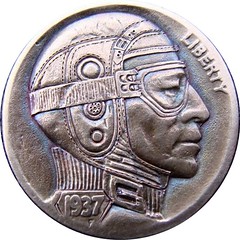
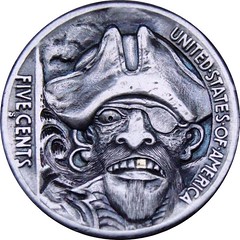
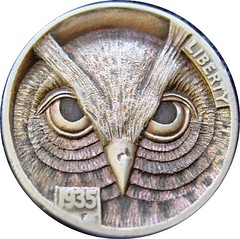
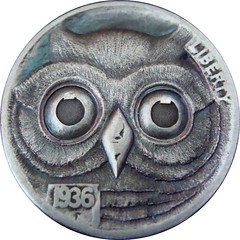
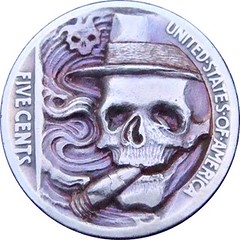
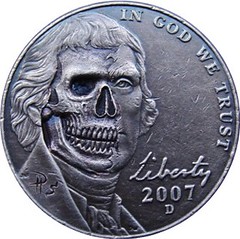
For more information on the Original Hobo Nickel Society, see:
www.hobonickels.org
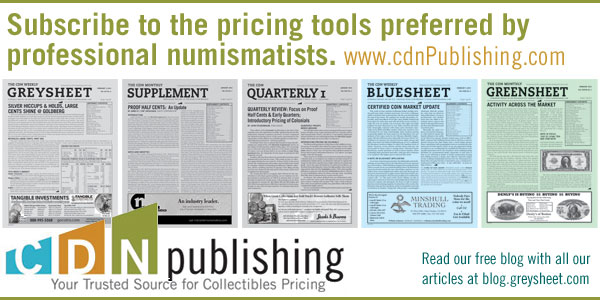
THE WALTER GLENN COLLECTION OF ART-DECO MEDALS
Regarding Bogomil Nikolov, Paul Bosco writes:
I have eight of his interesting large cast bronze medals on my subsidiary website, "artdecomedals.com". They all came from the estate of Walter Glenn of Georgia, one of my favorite customers.
When the The E-Sylum graciously plugged my listings of Alex Shagin medals, a couple readers effected the much-desired change of ownership.
The tiny "mintages" obscure the fact that there is a marketplace in the work of contemporary medallic artists. I am pleased to take part in it, but Medialia Gallery --which you can visit when you come to NYC-- is the real player. The director/founder, Mashiko, is a real treasure of New York.
ART-DECO MEDALS: The Walter Glenn Collection
Walter Glenn (1937-2013) was an avid collector, and a particularly skilled one. He knew how to buy, which is not such a rare skill, but he also knew WHAT to buy.
It's little wonder that Walter –sometimes called “Pete” – had a keen eye (and not just for medals). For 30 years he operated an art jewelry gallery, “Geode Ltd”, in Atlanta. Later, he sold on eBay with the seller ID “100mph”. A specialized website “Objexs” is still up & running: http://www.objexs.com/ (open for how much longer?).
Known widely in the South as an expert in American Art Deco, and especially Frankart, I would see Walter on his frequent trips to NYC. Often, he’d have some friends assemble at my store, buying a few medals until everyone had arrived. These became social occasions for me, too. Probably because of the breadth of his interests, and the love he had for each piece he collected, there was no customer who was more pure fun than Walter was -- without being Italian. (I guess he came from a fun family; he had sister named Doodle. Really!)
Many of my customers for medals buy most of their best pieces from me. There are not that many good sources; those dealers and auction houses that happen to offer the occasional piece are not known for their expertise and helpfulness. eBay? PLEASE!!
Now that I have Walter's entire medals collection before me, it is evident that he could buy more widely than most collectors. Still, I have in front of me now many of the best Deco medals I ever had, pieces I started to miss the moment Walter bought them.
One Old Friend, the Sugar Refinery of Port Jerôme, a Top-Five candidate among all Art-Deco medals, I offered to Walter in the 1990s for $600. He passed. A week or so later he called and said, “You were right about that piece; will you hold it for me?” When you see the picture of this piece, you will realize that it is always best to listen to Bosco. Or perhaps better advice is: remember what you see, and where you saw it. Take notes, or pictures. When and if you realize you were crazy not to buy a piece, it would be good to be able to do something about it. And remember this: (Bosco's Law of Dumb Thrift) You will regret something you DIDN’T BUY ten times as often as you’ll regret something you DID BUY.
Not every piece in the collection will make it to this webpage, but we will try, over several months, to present enough of the collection to show the current generation of medals enthusiasts some of the parameters and possibilities of collecting.
OK - here are a few of my favorites. -Editor
USA Rockefeller Center, 1935
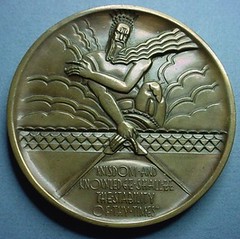
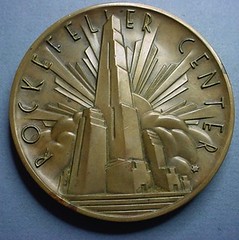
France D.A.M. Prix Concours d’Élégance, 1930 by Henri Demey
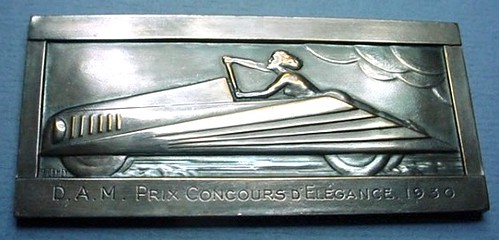
FRANCE Theatre, 1930, by Maurice Delannoy
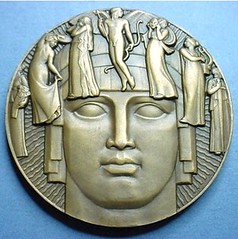
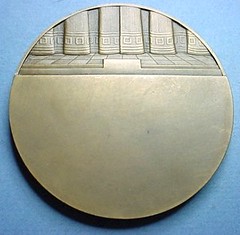
FRANCE Continental Edison Company, 1932, by Pierre Turin
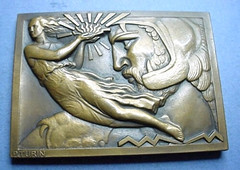
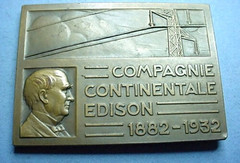
FRANCE Port-Jérôme Refinery, Inauguration, by Gustave Miklos, 1934
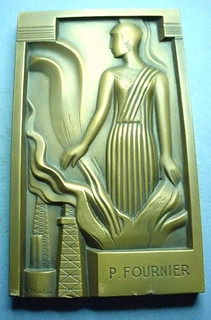
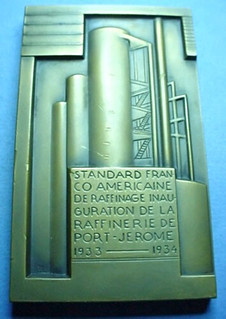
To visit Paul's Art deco medals site, see: http://artdecomedals.com/
To read the earlier E-Sylum article, see:
SELECTED MEDALS OF BOGOMIL NIKOLOV
(www.coinbooks.org/E-Sylum_v19n21a30.html)
P. SCOTT RUBIN ON AUCTION CATALOG RESEARCH
P. Scott Rubin Speaks at May Meeting of the New Jersey Numismatic Society
This article is dedicated to the memory of Dave Ginsburg, distinguished numismatic scholar and researcher.
Scott Rubin was a special guest speaker for the May meeting of the New Jersey Numismatic Society at the Madison (NJ) Public Library on May 16, 2016. Rubin, a lifelong New Jersey resident, started collecting coins in 1955. He has written articles for the ANS, ANA, NBS and Coin World. Scott has conducted research for many numismatic auction houses such as Stack’s, Bowers & Merena, Superior and Heritage. Rubin is retired from the State of New Jersey where he worked for nearly forty years as a computer analyst (from bio supplied by the speaker). At the present time, Scott collects New Jersey Colonial currency.
Ray Williams, a Colonial coin and currency specialist, introduced the speaker. Rubin's topic was “Numismatic Research from Auction Catalogues, Stories and Insights on How to Use Them.” The evening started out well for Rubin when he won the 50/50 (beginner's luck)!
Rubin recounted that in 1955, he noticed that coin dealers had old auction catalogues lying around. He started getting catalogues from Kagin's and Stack’s. Although Scott found very few specialized coin books in the 1960s, a few were available on half cents and large cents so he started collecting those coins. Scott began to do research for Walter Breen and Roger Cohen from information he gleaned from auction catalogues.
Scott talked about how to use an auction catalogue and the ways in which dealers such as B. Max Mehl marketed their products. Rubin taught himself how to discern which dealers could be trusted with their photographs. Images of coins which appeared in catalogues weren’t necessarily the coins that were in that sale! He also investigated how to decipher catalogue pedigrees and identify frequent errors found in numismatic catalogues published prior to and including the 1960s. Fortunately, dedicated cataloguers at companies like Heritage and Stack's Bowers are doing extensive research to ascertain correct pedigrees. As an example, Scott cited the phenomenal job done by John Kraljevich who conducted pedigree research for the Pogue Auction catalogues.
Rubin owns over 10,000 U.S. numismatic auction catalogues and numerous foreign auction catalogues as well. He continues to keep computer records on 212 federal issue U.S. coins and has gone through each of the 10,000 catalogues at least once. Three numismatic dealers of note that Scott dealt with were Frank Katen, Aaron Feldman and James Brown. Scott shared some of his favorite memories and stories about these figures. Rubin noted that we are now living in the golden age of numismatic research with the internet and other tools available such as the Newman Portal to help get more numismatic material online!
After NJNS President Dave Bailey thanked Scott for his exemplary and humorous talk, the audience had numerous questions for Rubin during the Q & A session. Society members were grateful to Rubin for making the long trek from Lawrenceville, NJ, to spend the evening with us. It was a night to remember.
THE BOOK BAZARRE
POEMS OF ERIC P. NEWMAN
A NUMISMATIC BOOK
The American Accomptant by Chauncey Lee
At a George Kolbe auction was acquired by me.
Its condition was choice for its 1797 date
And unfolding corners a welcome fate.
The first printed dollar sign was its principal feature
And its money exchange tables a valuable teacher.
Its only plate of coins is a gem indeed
Done by New York Bank note-engraver Abner Reed.
I will give its numismatic content many more looks
Now that it's one of my favorite books.[i]
ODE TO A BIBLIOPHILE
Francis D. Campbell is our great Frank.
For his brilliance and cooperation we're all here to thank.
As a skilled librarian in bibliography,
He also knows lexicography and iconography,
Holography, cryptography, and historiography,
Typography, siderography, and metalography.
He can explain obverse, reverse, inverse and transverse
Along with complex coin varieties diverse.
He can read Chinese, Maltese, and Annamese
and even interpret Brothers Chapmanese.
He stutters in Turkish, Kurdish, Finnish, and Yiddish
But if all else fails he's fluent in Gibberish.
He received publications in sacks and packs,
Decides what is written by hacks and quacks,
Finds too many catalogs from 57th Street Stack’s,
Puts all books in racks on tracks,
Offers them to numismaniacs,
Careful to watch for kleptomaniacs.
Campbell's retirement has thrown ANS in a loop.
His successor must drink lots of canned Campbell's Soup.
Eric P. Newman
March 26, 2008[ii]
BUY THE BOOK INSTEAD OF THE COIN FOR 7,590,020 REA$ON$
The book Illegal Tender is a “novel” expression
About a 1933 U. S. double eagle minted impression
Struck during the Great American depression
When gold coins were ordered into suppression.
Some ’33s were then stolen from Treasury possession
Through some conniving mint workers’ indiscretion;
Then sold through dealers in the coin profession
To collectors afflicted with rare coin obsession.
After two pieces were saved for Smithsonian accession
T-men grabbed others in Federal repossession
Litigation ensued about the right of possession
Leaving collectors none but a very clear lesson.
In a diplomatic pouch on went to Farouk, the Egyptian,
Through stupidity US granted export permission.
After Farouk fled, Egypt seized and auctioned his collection
But his ’33 vanished into clandestine protection.
Later smuggled back to the US for selling session
Right into a Secret Service sting for repossession.
Then was auctioned for price too high for addition
To become an anonymous buyer's best acquisition.
David Tripp's book is full of numismatic erudition,
Not about raising a coin to MS 80 condition,
But research done by an enigmatic magician,
It's wise to buy this book legally in its first edition.
(An apology to the sound advice of Aaron R. Feldman to buy the book before the coin)
Eric P. Newman, August 2004[iii]
On the occasion of the sale of Eric's colonial coins, sold by Heritage Galleries in New York City on May 16, 2014, Newman offered up the following verse which was read to the bidders. The “ice cream and birthday cake” refers to the cake and ice cream served by Heritage in honor of Eric's 103rd birthday.
Thanks, Heritage, for the ice cream and birthday cake.
We appreciate the bids you all may make.
Perhaps this will help you to stay awake
Even though there happens to be no fake.
And thanks for your singing and celebration
To a numismatist so long in circulation.
Notes
[i] The Asylum, Winter, 1988, Vol. 6, No. 4, 100.
[ii] Email from Frank Campbell to author (Augsburger), 3/6/2014.
[iii] American Numismatic Society Magazine, Vol. 3, No. 3, Winter, 2004, 37.
To read the earlier E-Sylum article, see:
HAPPY BIRTHDAY, ERIC P. NEWMAN (www.coinbooks.org/E-Sylum_v19n21a02.html)
FEIGENBAUM PREVIEWS POGUE IV SALE LOTS
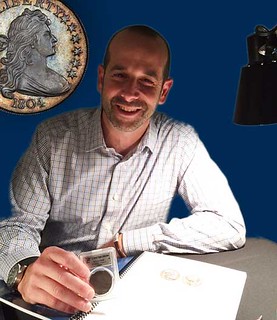 I arrived at the Sotheby's imposing building on 72nd and York on the upper east side of Manhattan around 2pm. The weather was beautiful
and the building magnificent. Forced to check my bag at entry, I went up to the fourth floor with only a small notebook and magnifying glass in hand.
(I had not been here since I had a front-row seat for the 1933 double eagle which sold here at auction in 2002 for $7.6 million!)
I arrived at the Sotheby's imposing building on 72nd and York on the upper east side of Manhattan around 2pm. The weather was beautiful
and the building magnificent. Forced to check my bag at entry, I went up to the fourth floor with only a small notebook and magnifying glass in hand.
(I had not been here since I had a front-row seat for the 1933 double eagle which sold here at auction in 2002 for $7.6 million!)
Melissa Karstedt of Stacks-Bowers, auctioneer and long-time friend, greeted me at the desk and escorted me to a private viewing area where I could carefully examine the entire collection.
It took me approximately two hours to view every lot in the sale, and would probably have gone more quickly except I kept coming back to the 1804. I was present in 1999 when this coin last sold at the Child's Sale (Bowers and Merena) also here in NYC. I was struck by it then, and it held my attention the same as before. I explained to the young woman showing me lots that this is the holy grail of numismatics, American or otherwise. There is possibly no more significant coin than this 1804 dollar.
Eventually though, I had to focus on the rest of the offerings. There are, after all 62 other coins in the sale, including the 1822 half eagle. The 1822 is a major rarity to be sure. It is the only example of this dated half eagle in private hands (two in the Smithsonian) but it is not equal to the 1804 dollar in sheer desirability. Unlike the 1804 many of us lifetime numismatists did not spend our childhoods coveting the issue. None of us ran around at coin shows in our teens dreaming that "one day I will own an 1822 half eagle." It's collectibly-unique status puts it in a sort of numismatic purgatory.
The other 61 coins in this sale were hand-picked beauties, carefully selected by the Pogue family and their advisors and I dare say any coin collector with an opportunity to view these in succession is somehow enjoying a perverse moment of someone else's private collecting life. The quality and beauty of these coins is NO accident. I am struck by the overall originality and quality of the collection. There is a choice near-gem example of the famous proof-only (specimen??) 1838-O half dollar PCGS SP64 -- also a legend among collectors.
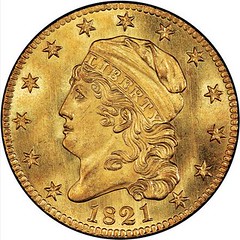 The first half eagle lot in the sale is an 1821 "five" graded PCGS MS66+ and it knocked my socks off. John Albanese, President of
CAC, had prepared me for this coin but I had let my guard down thinking of the 1822. The 1821 is a wonderful gem of the quality I had not known was
possible for this rare type.
The first half eagle lot in the sale is an 1821 "five" graded PCGS MS66+ and it knocked my socks off. John Albanese, President of
CAC, had prepared me for this coin but I had let my guard down thinking of the 1822. The 1821 is a wonderful gem of the quality I had not known was
possible for this rare type.
The series of $5 gold from 1813-1829 is usually referred to as "Capped Bust, large size." Most of us have seen a fair number of 1813, 1814/3 and 1818's from the series, but otherwise it's as if there are no other issues in this series. You simply NEVER see them. The series of coins from 1829-1834 is referred to as "Capped Bust, small size", or more endearingly as the "Fat Head Fives" for their odd appearance. These are even more rare as a series and nobody in their right mind would attempt to collect a complete set of these, would they??? But Pogue did. Not only that, every coin is of exceptional quality with nothing lower than MS63 save for the lone 1822.
I was blown away by the beauty and quality of every one of the early fives in Pogue IV. And I am not alone. The rumble on the street is that this run of coins is without peer. They are monstrously rare and, much like this wordy article of mine, overshadowed by the two famous rarities that highlight the sale.
To read the complete article, see:
Today
I was a kid again... John F muses on his visit to Sotheby's to view the Pogue IV auction lots
(http://blog.greysheet.com/2016/05/24/today-i-was-a-kid-again-john-f-muses-on-his-visit-to-sothebys-to-view-the-pogue-iv-auction-lots/)

POGUE IV SALE RESULTS
Part IV of the D. Brent Pogue Collection, offered by Stack's Bowers Galleries and Sotheby's at Sotheby's New York galleries, realized a total of $16,749,038 for 61 lots, with an average lot value of more than $274,000 per coin. The Farouk-Pittman 1833 Proof half eagle led all coins sold at $1,351,250. A famed 1795 Draped Bust silver dollar, last sold in the 1980 Garrett Collection sale, also surpassed the million-dollar mark, realizing $1,057,500.
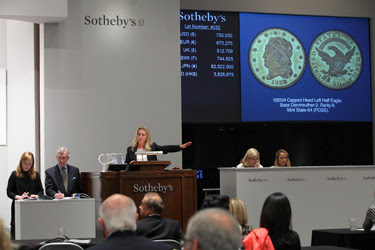
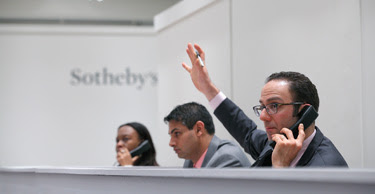
Statistician for the coin hobby, P. Scott Rubin reported, “At $85,318,218.50 the Pogue Collection is now far and above any other collection ever sold at auction in total proceeds and there is still more to go! The 61 coins that sold brought over the high estimate value for those, setting numerous records along the way. Eleven coins pedigreed to the D. Brent Pogue Collection Part IV will now be included in the Top 250 auction records.
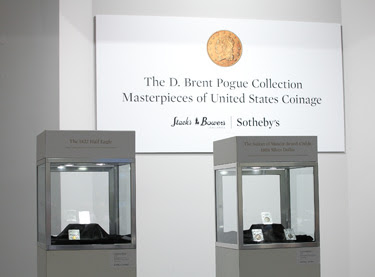
“Our sale of the D. Brent Pogue Collection, which is still ongoing, has broken world records left and right. Nothing like it has ever happened before! Considering the rarity and the quality of the coins offered, it will never happen again. As I said before, those participating have had a rendezvous with destiny!” remarked Stack's Bowers founder Q. David Bowers.
A world record sum of $10,575,000 was bid from the phone for the finest known 1804 dollar, the highest price ever offered for any coin, but it did not surpass the consignor's reserve price. The previous world record of $10,016,875 was bid in the Stack's Bowers Galleries January 2013 sale of the finest known 1794 dollar.
The only collectible specimen of the extremely rare 1822 half eagle, or $5 gold piece, received a phone bid of $7,285,000, a bid surpassed among gold coins by only the 1933 double eagle $20 gold piece that brought $7,590,000 in 2002. The 1822 half eagle was retained by the consignor after it did not meet their reserve price. Only two other examples of this rarity exist, both in the Smithsonian Institution.
Eight additional coins sold for more than a half million dollars, led by the finer of two known 1825/4 half eagles which brought $940,000. Three other half eagles realized $822,500 each: the 1829 Small Planchet $5, the 1832 12 Stars $5, and the 1835 Proof $5. A superb 1795 Draped Bust dollar brought $763,750. The same sum, $763,750, purchased the 1829 Large Planchet half eagle. The first half dollar of the New Orleans Mint, the extremely rare 1838-O, brought $493,500. The finest known 1838-C half eagle, struck in the first year of production at the Charlotte (NC) Mint, realized $235,000 against a $60,000-$90,000 estimate. The prices realized for the night totaled $16,749,038.
To read the complete article, see:
Pogue IV Auction Sells 61 Coins, Surpasses $16
Million (www.stacksbowers.com/News/Pages/PressReleases.aspx?ArticleID=159)
BILL GIBBS ON THE POGUE IV SALE
For some observers, the failure of bidders to meet the reserves for the 1804 dollar and 1822 half eagle in the Pogue IV auction was a sign of trouble for the market in high-end coins. However, the real story appears to be that of a collecting family that could not bear to part with two of their favorite coins, even with an offered total price of nearly $18 million.
The 1804 dollar received a final bid that, with the 17.5 percent buyer's fee, would have totaled $10,575,000, a world's record for any coin. The 1822 half eagle garnered a final bid that, with the buyer's fee, would have totaled $7,285,000, a bid surpassed among gold coins by only the 1933 double eagle that brought $7,590,000 in 2002. Both prices would have well exceeded what the Pogue family paid for the coins ($4.14 million for the dollar in 1999 and $687,500 for the half eagle in 1982). But still, no sale.
Christine Karstedt, executive vice president of Stack's Bowers Galleries, said that in the end, the sentimental value outweighed the financial reward and the family decided to keep the coins instead of accepting the bids.
The 1822 half eagle has been part of the Pogue Collection since the current owner, Brent Pogue, was a teen. His father, Mark, who started the collection, had purchased the coin while Brent competed in a track meet with his high school team, though the younger Pogue had examined the coin during lot viewing.
The younger Pogue wrote about the family's purchase of the gold coin in his introduction to the book The 1822 Gold Half Eagle by Q. David Bowers. He noted in that introduction that the two coins the family has elected to keep are among his personal favorites.
To those who choose to focus on just these two coins and see the situation in a negative light, look at the bigger picture. After four auctions, the Pogue Collection has raised $85,318,218.50. That's a record already for any single collection, and its sale is not over.
The Pogue Collection was clearly assembled over the decades by a family of collectors with a deep admiration of early U.S. coins. Who can blame them for deciding to keep a couple of the greatest coins in American numismatics?
To read the complete article, see:
IN THE END, THE SENTIMENTAL VALUE OUTWEIGHS THE
FINANCIAL REWARD (www.coinworld.com/voices/bill-gibbs/2016/05/in_the_end_the_sent.html#)
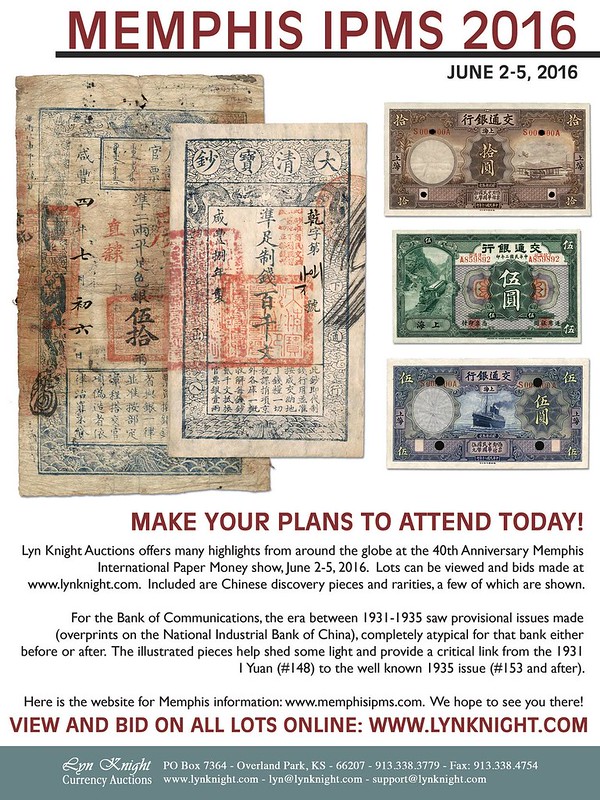
ROBERT KORVER ON POST-AUCTION PURCHASES
You must understand that the prevailing mentality at Heritage -- and at every other auction firm -- was that we DID NOT like Reserve bids. We were in business to auction coins, not to return them to a consignor because he or she thinks they are worth more than EVERY OTHER numismatist in the universe. We had, on occasion, sold a lot after an auction to a bidder who, say, had a flat tire on the way and missed his lot (which hadn't sold) but the standard rule was "WE HOLD ONLY ONE AUCTION!"
On to the heart of the story. After the last lot sold, a bidder I recognized as successful came up to the Podium with a sad story. While he had successfully bid on $10,000 in Standing Liberty quarters, he had been saving the bulk of his wallet to bid on an extraordinary 1927-S in MS66; unfortunately (for him) it went for thousands more than his absolute top bid. Then he said the magic words to me: "I have another twenty-five thousand dollars to spend, and I let any number of quarters sell to their reserves rather than chase them. Can I buy some of those now?"
Did I mention I was tired? I asked the auctioneer if he would stay for another 15 minutes (redoing all the paperwork really took two people). Did I mention he was exhausted as well? He looked at the bidder, and decided that he didn’t need a new NBF (Numismatic Best Friend). "WE PREFER TO HOLD ONLY ONE AUCTION", he sniffed, and walked out of the room. Perhaps to bed, perchance to dream.
I had noticed during the auction that this entire run of Quarters had been reserved by the consignor, and several did not sell. I asked my 'Second Auction' bidder how much more he wanted to spend, hoping he would give me a small number that would allow me to scamper to my Number Running as well. He said "ALL OF IT." And that was the moment of epiphany -- well, that and about 5 seconds of quick calculations.
At that time, the average consignor probably paid about a 3% Reserve Fee. This varied widely of course, but during my three seconds, I figured 3% was close enough. All of our production costs, as I well knew from my position of Auction Director at Heritage, were sunk. Catalogers were paid, photographers were paid, graphic artists were paid, printers were paid, the Post Office had been paid. If I sold $10,000 of buybacks to my new NBF, the company would earn his 10% buyers fee PLUS a 5% Sellers Fee. In short, a little more than 12% (it's more because the 15% is on an increment or half-increment higher than the 3% Reserve amount. On $10,000 in extra sales, the company would earn more than $1,200 — times two — of pure profit. Not bad for 15-30 minutes of paperwork.
So I stayed, and my NBF bought every reserved lot still available to him: 4 coins, for $26,125. For my 30 minutes of work, I made one bidder happier (he got to empty his wallet); one consignor happier (he got a check for $25k more), and Steve Ivy happier, as his prices realized were higher, sell-through rates were higher, and Heritage Numismatic Auctions earned an additional $3,135. Besides, I wasn't going to be sleeping anyway. And, I say this: my NBF did it right. He didn’t dither, he didn’t discuss, he BOUGHT — and he bought them all! That's how to impress me, even after the point of exhaustion. I like bidders who know what they want, and I like PURE PROFIT!
That ANA was successful. But on the flight home, I thought about the $2 million-plus in buybacks, and wondered just how much of that could be converted from 3% to 15% revenue generation by reaching out to 7,500 bidders, instead of just one!
It took me more than a year to convince the Executives that "We prefer to hold only one auction", while a good policy, and time tested, it was not the Holy Grail. And the new policy had the advantage of differentiating Heritage from all other auctioneers, an important marketing strength: WE NEVER STOP TRYING TO SELL YOUR COINS.
Bottom line, happier consignors and happier bidders. How much happier? When I stopped counting several years ago, Heritage had already sold more than $250 million through its Post Auction Buys, and that is a whole lot of happiness for all parties concerned. Especially Heritage, earning more than 10% on that with but the smallest of additional programming expenses.
Incidentally, the fear (often expressed before implementation) that the new policy would reduce auction proceeds (because bidders would wait until after the auction to chase reserved lots) did not come true; quite to the contrary. Knowing that ALL reserved lots would be made available to thousands of bidders afterwards motivated Heritage's clients to bid and buy during the first auction. Now, it seems the initial bidders prefer to hold just one auction...
To read the complete article, see:
A New Auction Purchasing Paradigm
(www.numistorica.com/a-new-auction-purchasing-paradigm.html)

Archives International Auctions, Part XXXIII
Chinese, Asian &Worldwide Banknotes,
and Chinese Scripophily
June 28, 2016
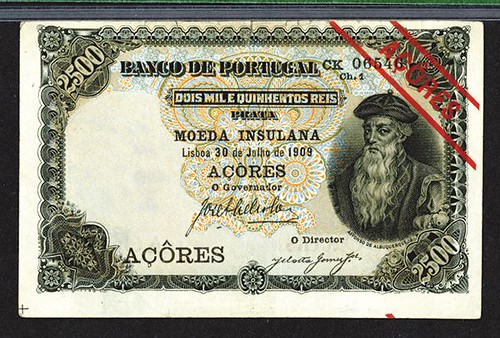
Click the links! Highlights include:
Lot 198: American-Oriental Banking Corporation, 1919 “Shanghai Branch”
Lot 245: Dah Chon Chang Money Exchange, ca.1920's "Shanghai"
Lot 315: Republik Indonesia Unlisted 1948 Issue Essay Specimen
Lot 451: Banco de Portugal - Azores. 1909 Issue
Lot 475: Imperial Do Brazil (1882) Issue Color Trial Essay Proof
Lot 700: Comite Bancario de Guatemala. 1899 Issue
Lot 889: Bank of Rhodesia & Nyasaland. 1960 Issue.
Lot 1006: Central Bank of Turkey. 1930 Law Issue
View the Virtual Catalog
Download the Catalog in PDF format
ARCHIVES INTERNATIONAL AUCTIONS, LLC
1580 Lemoine Avenue, Suite #7
Fort Lee, NJ 07024
Phone: 201-944-4800
Email: info@archivesinternational.com
WWW.ARCHIVESINTERNATIONAL.COM
SELECTIONS FROM EARLY AMERICAN JUNE 2016 SALE
Lot 2107: New Jersey. First Presbyterian Church One Penny
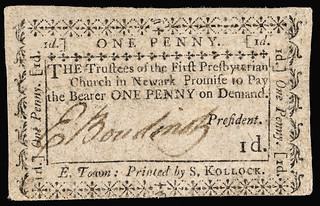
New Jersey. First Presbyterian Church at Newark. December 16, 1790 Issue. ONE PENNY denomination. Extremely Fine.
This well printed and nicely centered, typeset small change private issue Church Money note is typeset at bottom: “E. Town: Printed by S. Kollock.” This denomination has the text “One Penny” on both left and right, whereas the date is typically seen printed along the right side. It has all of its border designs distinct and present with the text clearly readable. The signature of “E. Boudinot” as President is large and beautifully written in brown ink, having one of the finest examples of his signature we have seen. Likely less than two dozen or so known to exist and not listed with a value in Newman due to its rarity. Near impossible to locate in high quality and is an important, historic American rarity. Elias Boudinot was a member of the New Jersey Committee on Correspondence (1774-1775) and the New Jersey Provincial Congress (1775). In 1777 he was appointed commissary-general of prisoners. He was a member of the Continental Congress (1777-1788; 1781-1784) and its President (1782-1783).
He signed the treaty with Great Britain to end the war. He served in first Congress of 1789; in 1795 was made the third Director of the United States Mint, and from 1816 to 1821 served as the first president of the American Bible Society.
To read the complete lot description, see:
www.earlyamerican.com/Auctions/ClientPages/lots.item.php?auction=53&lot=2107
Lot 2162: New Hampshire. December 25, 1734. Seven Shillings
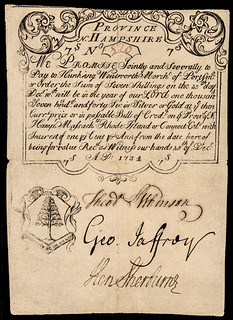
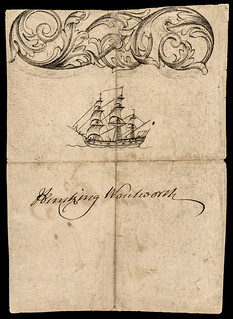
Province of New Hampshire. December 25, 1734. Seven Shillings. Hunking Wentworth Portsmouth Merchants Note. (For the benefit of trade) Legend. Seven Shillings. PCGS graded Very Fine-35.
Fr. NH-38.4. Important Large Format 1734 New Hampshire rarity, boldly printed and well centered on very clean, bright paper having excellent margins on all four sides. Apparent repaired splits noted, as vertical centerfold has seal has clear early archival fiber tape reinforcement on the blank reverse. Nicely signed in red and bold brown ink by Theodore Atkinson, Henry Sherburne and George Jaffrey. Signed on back “Hunking Wentworth,” for circulation, being the assignee Merchant who's name appears in the printed text on that face side. This boldly printed note is on crisp laid period paper displaying significant eye appeal. The top has a printed text agreement which reads, in part:
"We Promise Jointly and Severally to pay to Hunking Wentworth of Portsmouth Merchant or Order,” within a simple rectangular frame with rounds, at the top is the scroll indent and below "PROVINCE - OF - N. HAMPSHIRE".
The lower left shows the New Hampshire Colony Seal with its Pine Tree vignette within an ornate design, with the motto: “BENEFICIO COMMERCI” (For the benefit of trade). The reverse side displays an ornate scroll design printed at the top with Sailing Ship vignette, shown heading towards the West, indicating the direction towards the American Colonies.
To read the complete lot description, see:
www.earlyamerican.com/Auctions/ClientPages/lots.item.php?auction=53&lot=2162
Lot 2149: State of Georgia. October 16, 1786. Twenty Shillings.
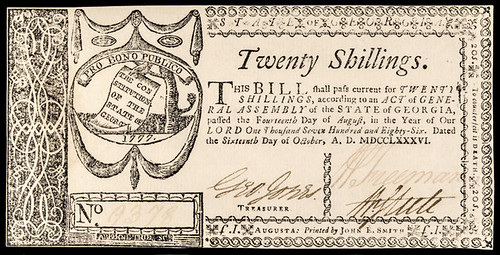
State of Georgia. October 16, 1786. Twenty Shillings. PCGS graded Choice About New-55.
Fr. GA-131. This fresh, bright and highly distinctive looking 1786 Georgia issue note was engraved by “Abernathie, SCT.” (sculptor) with his name printed in reverse within the black ornate design block located just below the written serial number. It is printed on high quality clean white period laid paper supplied by John E. Smith of Augusta, Georgia. This note has the overall eye appeal and appearance of Crisp Uncirculated with only a light crease seen on its blank reverse. Once hinged by a 1” spot of old glue seen at the right side of the reverse, accounting for the term Apparent by PCGS with comments, mounting remnants and stain on back. Signatures include; George Jones, W. Freeman and W. Steele.
To read the complete lot description, see:
www.earlyamerican.com/Auctions/ClientPages/lots.item.php?auction=53&lot=2149
Lot 2122 : Virginia, “NORFOLK LOTTERY” Ticket
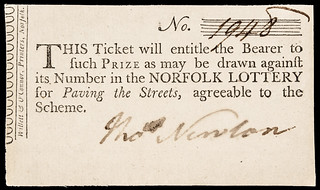
c. 1796 Federal Period, Virginia, “NORFOLK LOTTERY” Ticket. “for Paving the Streets,” Gem Crisp Uncirculated.
This “Norfolk Lottery” Ticket measures 4” x 2.25”, trimmed along left side, no folds, on laid paper. Ticket reads, "This Ticket will entitle the Bearer to such Prize as may be drawn against its Number in the NORFOLK LOTTERY for Paving the Streets, agreeable to the scheme.” Signed by “Thos Newton”. “Willett &O’Connor. Printers, Norfolk.” printed along left border. Extremely bright, fresh crisp and bold with significant traces of original press text embossing within the laid period paper. The first we have offered and quite superb!
To read the complete lot description, see:
www.earlyamerican.com/Auctions/ClientPages/lots.item.php?auction=53&lot=2212
Lot 2215: Mercantile Dining Room, U.S. Postage Stamp Envelope
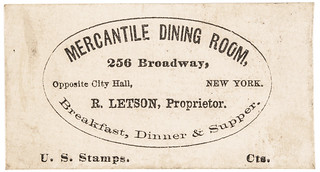
Mercantile Dining Room, U.S. Postage Stamp Envelope, 256 Broadway NY (Blank) Cts. PE489. “White Paper” variety. Extremely Fine.
M. Friedberg #90, #KL72-O. Black printed text on white envelope, “MERCANTILE DINING ROOM,/ 256 Broadway,/ Opposite City Hall, NEW YORK./ R. LETSON, Proprietor./ Breakfast, Dinner &Supper./ U.S. Stamps. Ct.” This is an exceedingly rare merchant with just Two Examples Known according to author Fred Reed.
To read the complete lot description, see:
www.earlyamerican.com/Auctions/ClientPages/lots.item.php?auction=53&lot=2215
Lot 2218: Niblo's Garden U.S. Postage Stamp Envelope
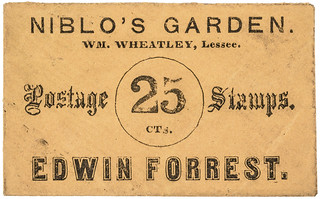
Edwin Forrest, Niblo's Garden, (New York) 25 Cents U.S. Postage Stamp Envelope, PE537. Choice Extremely Fine.
M. Friedberg PE537. #KL-97-25. Black Printed text on Orange paper envelope. “NIBLO's GARDEN./ WM. WHEATLEY, Lessee./ Postage 25 CTS. Stamps./ EDWIN FORREST.” Complete except for the backflap. Fred Reed indicates only Five to Ten Examples Known, with those being spread across six varieties, thus all are very rare.
To read the complete lot description, see:
www.earlyamerican.com/Auctions/ClientPages/lots.item.php?auction=53&lot=2218
Lot 2226: 12¢ "Take Ayer's Pills" Encased Postage Stamp
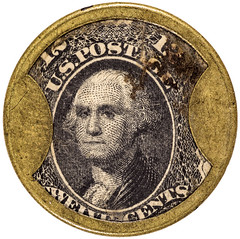
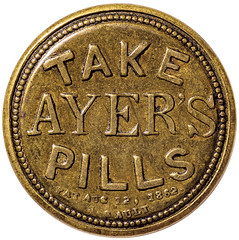
EP-136, HB-23, S-12, Reed-AP12. Twelve Cents. TAKE AYER'S PILLS. Choice Extremely Fine.
Rated as Rarity-8 (5 to 10 known) according to Fred Reed. This 12¢ denomination is a great rarity, being only the fifth EP-136 we have offered in over four decades (one of those being a defective Very Good).
To read the complete lot description, see:
www.earlyamerican.com/Auctions/ClientPages/lots.item.php?auction=53&lot=2226
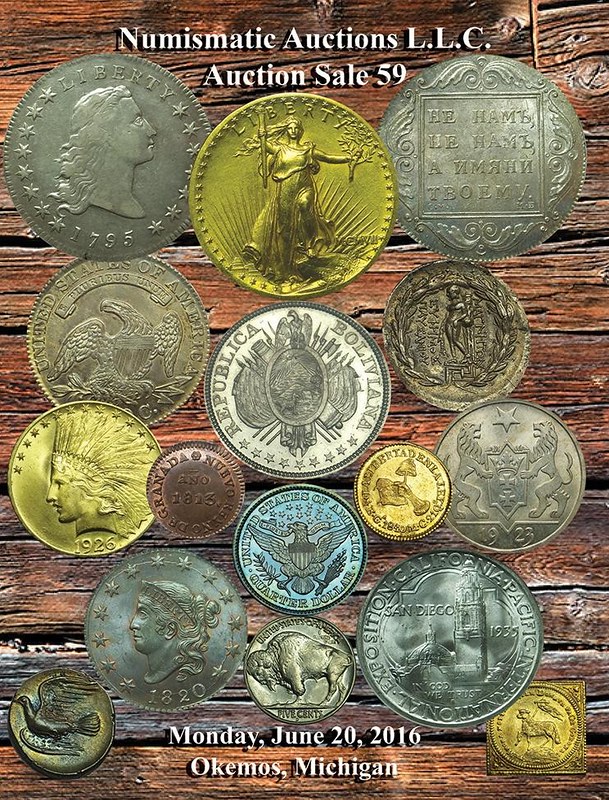
SELECTIONS FROM THE 2016 MEMPHIS WORLD PAPER MONEY SALE
Lot 3000: Afghanistan 2a 5 Rupees SH1298
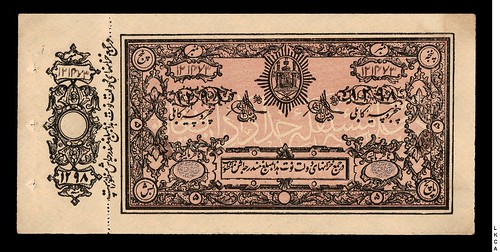
To read the complete lot description, see:
http://lynknight.com/ShowAuctionDetails.Asp?auction_Id=269762
Lot 3008: Algeria 109? 5000 Francs 0-0-0000
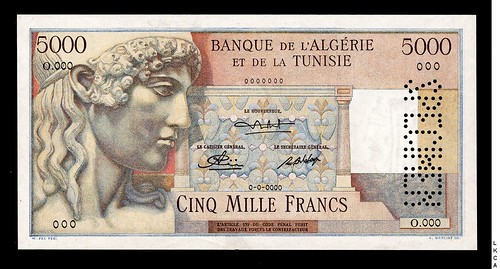
To read the complete lot description, see:
http://lynknight.com/ShowAuctionDetails.Asp?auction_Id=270974
Lot 3084: Austria 81 100,000 Kronen 2.1.1922
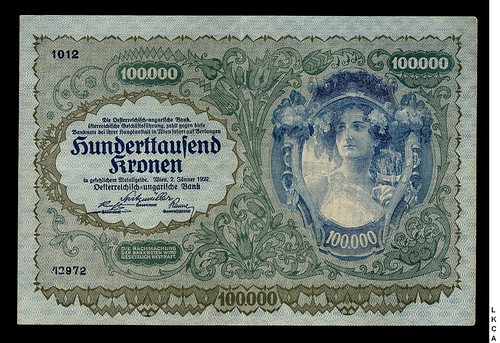
To read the complete lot description, see:
http://lynknight.com/ShowAuctionDetails.Asp?Auction_ID=270050
Lot 4338: Sri Lanka 89b 500 Rupees 1.1.1985
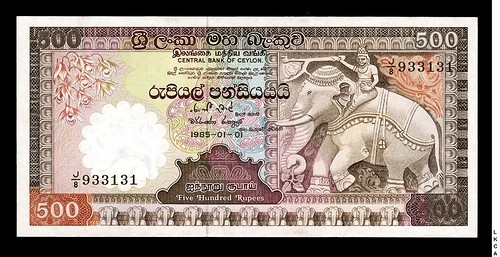
To read the complete lot description, see:
http://lynknight.com/ShowAuctionDetails.Asp?auction_Id=269791
Lot 5291: National Bank Notes > District of Columbia Washington, Riggs NB, 5046
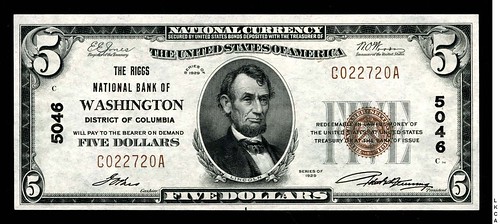
To read the complete lot description, see:
http://lynknight.com/ShowAuctionDetails.Asp?auction_Id=270545
Lot 5753: Utah Scipio Co-Operative Mercantile Institution 50c
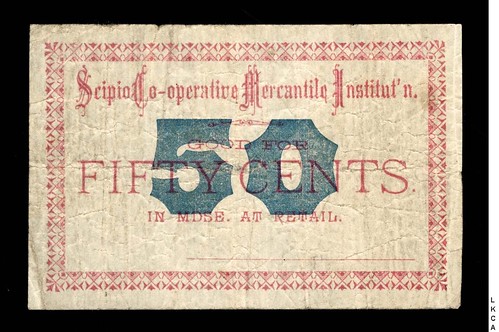
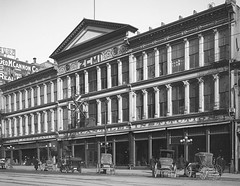 Zion's Cooperative Mercantile Institution (typically referred to as ZCMI) was the first department store in the United States. It was
founded on October 9th, 1868 by Brigham Young. For many years it used the slogan, "America's First Department Store".
Zion's Cooperative Mercantile Institution (typically referred to as ZCMI) was the first department store in the United States. It was
founded on October 9th, 1868 by Brigham Young. For many years it used the slogan, "America's First Department Store".
ZCMI became a formidable business force, eventually manufacturing its own line of boots and shoes, and a line of work clothes. It also sold everything from housing needs, lumber, nails, and the like, to household needs such as fabric, needles, thread, food preservation products, furniture, and draperies, even some beauty products; nearly everything the pioneers needed to survive and thrive.
Based in Salt Lake City, Utah, it quickly became a household name in the community. The LDS Church was a significant influence in the company, retaining a majority interest in ZCMI until its eventual sale.
To read the complete article, see: ZCMI (https://en.wikipedia.org/wiki/ZCMI)
To read the complete lot description, see:
http://lynknight.com/ShowAuctionDetails.Asp?auction_Id=271514
Lot 6046: Panic Scrip Parson, KS Parsons Commercial Bank Cashier's Check $5
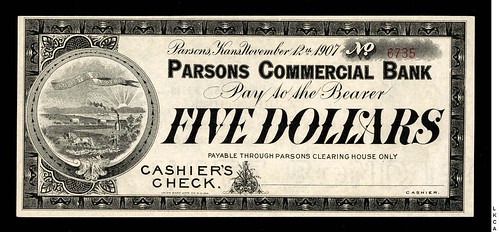
To read the complete lot description, see:
http://lynknight.com/ShowAuctionDetails.Asp?auction_Id=271539
Lot 6058: Panic Scrip Kingfisher City Village, Oklahoma Territory $1
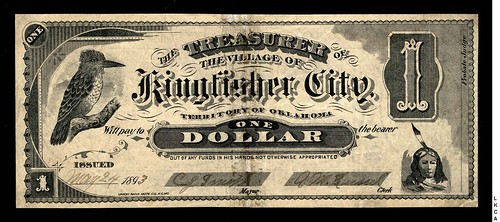
To read the complete lot description, see:
http://lynknight.com/ShowAuctionDetails.Asp?auction_Id=271540
2016 WORLD STAMP SHOW OPENS IN NEW YORK
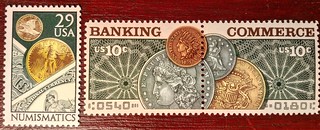 The World Stamp Show, held once every ten years in the United States, opened this weekend at the cavernous Jacob K. Javits Convention
Center in New York City. Enthusiasm is high as throngs are expected to purchase, exhibit and discuss stamps over eight days.
The World Stamp Show, held once every ten years in the United States, opened this weekend at the cavernous Jacob K. Javits Convention
Center in New York City. Enthusiasm is high as throngs are expected to purchase, exhibit and discuss stamps over eight days.
Two hundred fifty thousand attendees are anticipated for a convention with a $4.2 million budget. Each day has a theme and seven new stamps are scheduled for release with ceremonies. In addition to the usual bourse and auctions, there are more than 60 philatelic groups represented and hundreds of talks and meetings on a wide range of subjects are being given. One particularly popular activity is the cancelling of “passports” by representatives of more than fifty postal agencies from around the world. Eleven philatelic societies are holding dinners around New York City.
There are 700 exhibits and, as befitting a global event, these come from 76 countries. Of the many stamp rarities exhibited, the highlight surely is the legendary British Guiana one-cent magenta, valued at $9.5 million. This stamp, the world's rarest and the only remaining one of its type, is in private ownership. Although currently on loan to the Smithsonian Institution's National Postal Museum, it was moved to the show for temporary display.
Another rarity is the most famous American stamp, the 1918 Inverted Jenny air mail, featuring an upside-down, twin-engine biplane. An example of this popular 27-foot- long, Curtiss JN-4 is actually on display at the Javits Center as well.
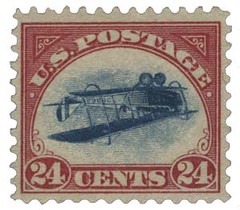 The story of the Inverted Jenny is legendary. A pane-- a small sheet-- of one hundred of these error stamps was printed, and the current
value of each of these 24-cent stamps is at least $500,000 and may sell for one million dollars or more.
The story of the Inverted Jenny is legendary. A pane-- a small sheet-- of one hundred of these error stamps was printed, and the current
value of each of these 24-cent stamps is at least $500,000 and may sell for one million dollars or more.
Colonel E. H. R. Green, the noted numismatist and philatelist, once owned the full sheet. He later divided the stamps, immediately selling some. Green's agent penciled a number on the back of each stamp, so it has been possible to trace the pedigree of virtually every one. That ability might appeal to many numismatists. The disposition of these stamps and their odyssey represent an interesting story itself.
The Inverted Jenny exhibited at the show, a near-perfect specimen identified as “the finest example,” will be auctioned on May 31 as part of the program. There even is a 62-page catalogue devoted solely to this stamp and its lore.
Philatelists, of course, collect stamps by country. But also popular are themes such as animals, ships, maps, historic figures, etc. There is some interest, too, in collecting stamps with coin themes. This may resonate especially with Baby Boomers, who grew up when hobby shops as well as Scouting stimulated appeal in both pursuits.
Since the early twentieth century, more than 180 countries have issued stamps featuring coins. There have been seven U.S. stamps with coins, although one of those was a fantasy. Occasionally, foreign mints release coins with a stamp image. Pobjoy Mint, a private company in England, has produced a series of coins commemorating the famous Penny Black, Penny Red and Penny Blue stamps of the mid- nineteenth century; these coins have been released on behalf of the Isle of Man or Ascension Island. The Penny Black, introduced in 1840, is identified as “the world's first adhesive postage stamp.”
The World Stamp Show, which ends June 4, has a huge New York area engagement. It is the first international stamp show held in Manhattan since 1956. That event was known as FIPEX 1956 for Fifth International Philatelic Exhibition.
Preparations have already begun for the next World Stamp Show in the United States, scheduled for Boston in 2026. The last was held in Washington, D.C., in 2006. For more on the current show, see: www.ny2016.org
CCAC TO VISIT THE 2016 ANA SUMMER SEMINAR

The Citizens Coinage Advisory Committee (CCAC) will meet at American Numismatic Association headquarters on the campus of Colorado College during the 2016 ANA Summer Seminar. Students, instructors, ANA staff, and members of the public are all encouraged to attend the CCAC's meeting on Monday evening, June 27. At this public meeting the Committee will review and discuss 2018 America the Beautiful quarter design proposals, and sketches for Barack Obama's presidential medal. Also on the agenda is a general discussion of the future of the palladium coinage program. The following morning, Tuesday, June 28, CCAC members will have breakfast on campus with Summer Seminar attendees.
“The ANA Summer Seminar offers a unique opportunity for the Committee to meet with coin collectors from around the nation,” said CCAC chair Mary N. Lannin. “Most of us are longtime collectors ourselves. We look forward to sharing ideas and hearing opinions from the hobby community to aid in formulating our recommendations.”
The eleven-member CCAC was established by Congress in 2003 to advise the Secretary of the Treasury on the themes and designs of all United States coins and medals. The Committee serves as an informed, experienced, and impartial resource to the Secretary of the Treasury and represents the interests of American citizens including coin collectors, historians, sculptors, numismatic curators, and the general public.
The ANA Summer Seminar is an annual event for numismatic learning and camaraderie that offers students a varied selection of weeklong courses designed for discovery or continued study. “Summer Seminar has helped inspire the careers of some of the country's most respected collectors, authors, and dealers,” said ANA President Jeff Garrett, who won a scholarship to attend Summer Seminar in the 1970s and later decided to become a professional coin dealer.
More information on the CCAC is online at:
www.ccac.gov
The American Numismatic Association web site is:
www.money.org
KING OFFA PENNY FOUND IN FIELD
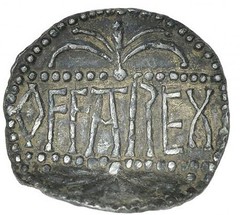 A LUCKY treasure hunter, who is just months away from getting married, is set for a £5,000 windfall after he discovered a rare coin in a
field near Stockbridge.
A LUCKY treasure hunter, who is just months away from getting married, is set for a £5,000 windfall after he discovered a rare coin in a
field near Stockbridge.
The soon-to-be bridegroom, who did not want to be named, uncovered the 1,200 year-old Anglo-Saxon penny while out and about with a metal detector.
The coin is said to be from the reign of the Mercian King Offa and is one of only two known survivors of its type.
Now the lucky 24-year-old builder, who gets married in July, could stand to gain a £5,000 pay-out from the discovery when it is auctioned in London on June 8.
The man, a builder who has been metal detecting since he was 13 years old, decided to search the field near Stockbridge.
He gained the consent of the landowner prior to the search and he will split half of the estimated £10,000 that the coin is expected to fetch at auction.
He added: “I had only been there a short time. About five minutes after I started I found a hammered coin and then two minutes later I discovered this one.
"I knew it was scarce because it had King Offa's name on it but I didn’t know how rare it was.”
Further research revealed that not only was the penny from the reign of Offa, who ruled the Anglo-Saxon kingdom of Mercia from 757 to 796, but it was made by the East Anglian moneyer Botred, whose coins for Offa are notably rare.
Only one other Offa penny by Botred is known to exist and that is in the collection of the British Museum and so will never be available to collectors.
Head of the coin department at Dix Noonan Webb, Christopher Webb said:“This is a truly remarkable find.
To read the complete article, see:
Saxon penny from the reign of Mercian King Offa in fields near Stockbridge
(www.andoveradvertiser.co.uk/news/14511049.Lucky_builder_set_
for___5_000_pay_out_after_discovering_rare_coin_
in_a_field_near_Stockbridge/)
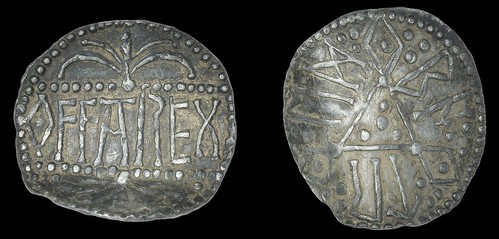
BRITISH COINS, Kings of Mercia, Offa (757-96), Penny, Light coinage, East Anglia, Botred, offa rex between two lines, ornate plants above and below, rev. bo tr ed in runes around a linear triangle, four pellets in centre, lozenge containing pellet at each point, 1.19g/12h (Chick 161; Blunt 108; N 332; S 904). Bent, otherwise good very fine, the second known specimen and the only one available to commerce £8,000-10,000
Footnote
In far superior condition to the only other specimen (British Museum)
To read the complete lot description, see:
BRITISH COINS, Kings of Mercia, Offa (757-96),
Penny, (www.dnw.co.uk/auctions/catalogue/lot.php?auction_id=434&lot_id=2046)

THE BOOK BAZARRE
TREASURE SHIPWRECK FOUND OFF NAMIBIA
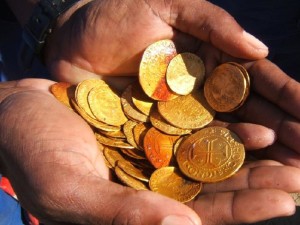 It was almost 500 years ago when The Bom Jesus, a Portuguese sailing ship, inexplicably vanished while en route to India. The vessel
was carrying an immense treasure that has eluded even the most ardent and focused treasure hunters. A recent discovery in the Namibia desert,
however, may signal the end of that hunt.
It was almost 500 years ago when The Bom Jesus, a Portuguese sailing ship, inexplicably vanished while en route to India. The vessel
was carrying an immense treasure that has eluded even the most ardent and focused treasure hunters. A recent discovery in the Namibia desert,
however, may signal the end of that hunt.
In 2008, miners were pushing their bulldozers across the golden sands, when they happened upon metal, wood, and pipes assembled in a strange, and at the time indiscernible, mass. A call was made to archaeologist Dieter Noli who quickly identified the objects on the “disturbed beach” as a shipwreck.
Amid the wreckage were 44,000 pounds of copper ingots, which archaeologist Bruno Werz believes allowed the ship to survive its 500-year isolation.
The ship's cargo matches that of The Bom Jesus, as articulated by the sixteenth-century book, “Memorias Das Armadas,” which lists the ship as lost. The ship mysteriously disappeared in 1533 which would make this the oldest shipwreck to be discovered in Sub Saharan Africa.
Nearly 24 pounds of treasure were discovered. Among these relics were 2,000 mint condition gold coins from Portugal and Spain, Portuguese silver coins, cannons made of bronze, tons of copper ingots, more than 50 elephant tusks, and navigational tools.
“We figured out the ship came in, it hit a rock and it leaned over,” said Noli. “The superstructure started breaking up and the chest with the coins was in the captain's cabin, and it broke free and fell to the bottom of the sea intact… In breaking up, a very heavy part of the side of the ship fell on that chest and bent some of the coins. You can see the force by which the chest was hit, but it also protected the chest.”
Arthur adds:
24 pounds? 24 tons? Somehow this doesn't make sense.
To read the complete article, see:
Treasure Shipwreck Found Off Namibia
(http://blog.gainesvillecoins.com/2016/05/22/treasure-shipwreck-found-off-namibia/)
To read another article, see:
Ancient ship found in desert -- with gold
aboard (www.wtsp.com/news/ancient-ship-found-in-desert-with-gold-aboard/213624502)

KANSAS WILCOX COIN COLLECTION HELP SOUGHT
I thought I would pass along a little information about the Kansas University coin collection I visited last week. I also visited the WWI museum in Kansas City. Fantastic museum but except for one small case and an item here or there, it was lacking in numismatic items on display.
This past week Rita and I drove to Lawrence, Kansas to watch our eldest grandson graduate with honors from Free State High School. Not often do I get to see a relative graduate with a 4.0+ for fours years of high school and was one (of 17!) valedictorians. They value education in university towns. Forgive me for the bit of bragging about my grandson but I added a numismatic connection with a picture of one side of the medal he was presented with.
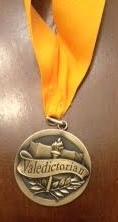 My main reason for writing is talk about the KU Wilcox coin collection. In all my years of visiting my grandchildren (and their parents) in
Lawrence I have tried to see the collection but I or my son Brian have been too late in our request. This past week I had an hour or so on both
Monday and Tuesday to see what they have.
My main reason for writing is talk about the KU Wilcox coin collection. In all my years of visiting my grandchildren (and their parents) in
Lawrence I have tried to see the collection but I or my son Brian have been too late in our request. This past week I had an hour or so on both
Monday and Tuesday to see what they have.
My son Brian is "digital" librarian at KU and he hooked me up with Phil Stinson. Phil is a professor of Classics and is co-director with Brian of their digital humanities center, and has recently been appointed head of the Wilcox Museum at KU. Their inventory lists about 6000 coins in the collection but probably less than 1/3 have been located. And the majority of those were found after 20+ years of being buried in a basement on campus.
Most of the coins have been donated by 4 or 5 people although I believe some were purchased years ago. The grades run from poor to near mint state. Most of the coins are ancient but there were some California gold fantasies, some Crusader pieces as well as some nice (and not so nice) early Islamic coins. The last donation was the "best" that I saw and the former owner had purchased some of the coins from Pegasi and Herb Kreindler. In addition I saw envelopes from the old-time dealer Edward Gans as well as what looked like envelopes of both Charles and his son Charlie Wolfe (or was it Wolf) of Ohio. The elder dealt in ancients, the younger in medieval coins.
Phil is looking for volunteer help in cataloguing and photographing the collection. One of the images I've attached show how the collection is basically stored. If someone who lives near Lawrence and wants to help in anyway please contact me and I can put you in touch with Phil.
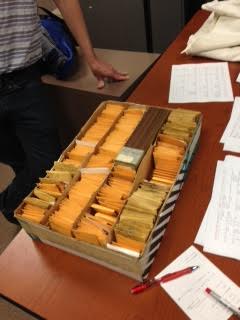
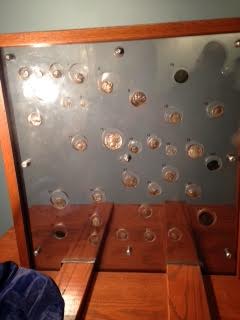
In addition Phil is looking for ideas on how to display the coins. The 50 or coins are now displayed in two glass (or plexiglass) frames so that they are visible on both sides. Unfortunately to look at the reverse you have to step over numerous wires. The lighting is poor and the coins do "move around" in the holder. Most of the coins I looked at were genuine although the large Syracuse Dekadrachm in the display case is a British Museum electrotype. There were a couple of other pieces that were questionable but unfortunately I neglected to bring a glass or a scale.
I know there are a number of numismatic museum curators and others who have helped with displaying coins. If you have any ideas Phil would be eternally grateful. If the coins are available for viewing a few of the viewers might just become hooked on numismatics.

MALAYSIAN COIN COLLECTORS LINE UP AGAIN
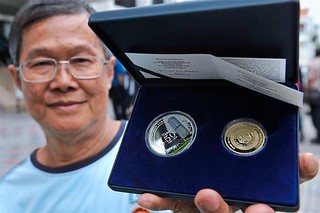 RETIREE Jang Eng Koon braved the rain to get commemorative coins issued by Bank Negara Malaysia (BNM) to mark the 50th anniversary of
Yayasan Sabah.
RETIREE Jang Eng Koon braved the rain to get commemorative coins issued by Bank Negara Malaysia (BNM) to mark the 50th anniversary of
Yayasan Sabah.
Jang, 69, turned up at the bank's Penang branch in Light Street, George Town, at around 9pm. He was among the long line of people who chose to wait overnight for the coins.
When the bank opened its doors 12 hours later in the morning, he was among the first to get the coins.
He bought a Coloured Silver Commemo-rative Coin (proof) and five pieces of the Nordic Gold Brilliant Uncirculated Commemorative Coin.
“I heard there were only 12 pieces of the Coloured Silver available at this branch. If I had waited until this morning to come here, I wouldn’t get the chance to buy.
“There was heavy rain last night so my friends and I waited together and sought shelter at a bus stop near the bank,” said the avid coin collector recently.
The Coloured Silver Commemorative Coin is a proof-coloured coin made of fine silver with 99.9 purity and weighs 31.10gm each.
It has a face value of RM10 and is sold at RM212 a piece. The mintage quantity is 500 pieces.
The Nordic Gold coin has a face value of RM1 and will be sold at RM10.60 each. The mintage quantity is 10,000 pieces.
On the obverse side of the coin, the centre shows the image and surroundings of Menara Tun Mustapha, also known as the Sabah Foundation Tower.
The words ‘Ulang Tahun Ke-50’ and the years ‘1966-2016’ denotes the 50th anniversary.
The foundation's name ‘Yayasan Sabah’ is featured on the upper circumference of the coin.
On the reverse side of the coin, the words “Bank Negara Malaysia’ as the issuing authority of the commemorative coin are featured on the upper circumference of the coin while the face value of the coin is inscribed on the lower circumference.
To read the complete article, see:
Long queue for special coins worth
it (www.thestar.com.my/metro/community/2016/05/23/long-queue-for-special-coins-worth-it/)
To read the earlier E-Sylum article, see:
MALAYSIAN COIN COLLECTORS LINED UP FOR NEW ISSUE
(www.coinbooks.org/E-Sylum_v19n10a29.html)

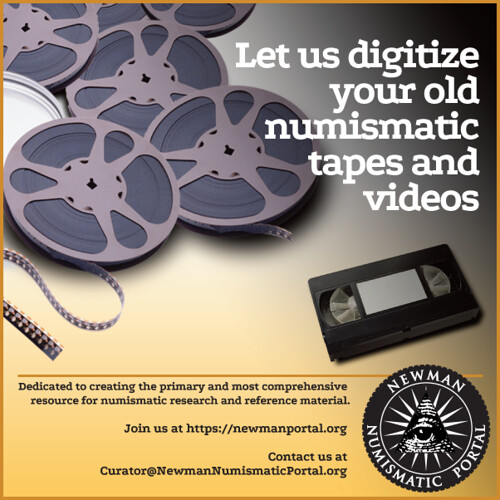
NORTH KOREA'S SECOND-DEGREE FRIENDSHIP MEDAL
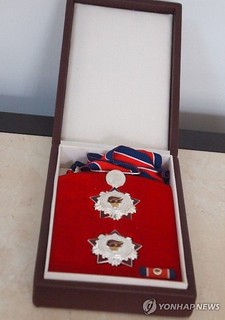 A medal that was apparently awarded by Kim Il-sung, the first Supreme Leader of North Korea and grandfather of current leader Kim Jong-un,
was found on a Mexican e-commerce website, Vivauncios. According to Vivauncios, Miguel Alba, a former professor at a university in Puebla, posted the
medal with an asking price of 76,995 pesos (4,153 USD) on May 13. He had already posted the medal on another e-commerce website, Segundamano, on May
9. Alba, however, later removed both posts, presumably due to concern over North Korean complaints.
A medal that was apparently awarded by Kim Il-sung, the first Supreme Leader of North Korea and grandfather of current leader Kim Jong-un,
was found on a Mexican e-commerce website, Vivauncios. According to Vivauncios, Miguel Alba, a former professor at a university in Puebla, posted the
medal with an asking price of 76,995 pesos (4,153 USD) on May 13. He had already posted the medal on another e-commerce website, Segundamano, on May
9. Alba, however, later removed both posts, presumably due to concern over North Korean complaints.
To read the complete article, see:
Rare Medal
Awarded by North Korea's First Supreme Leader Found on an E-commerce Website
(http://koreabizwire.com/rare-medal-awarded-by-north-koreas-first-supreme-leader-found-on-an-e-commerce-website/55447)
ANTI-SEMITIC BANKNOTES
Notgeld
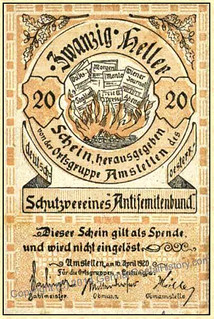 During and following the German hyperinflation of 1923, the worthless large-denomination Reichsbank currency was widely overprinted with
various anti-Semitic, anti-Communist, anti-capitalist, anti-inflation, Nazi-inspired, and political slogans. In many towns, special notgeld were
issued, often with racist or militant propaganda in their design.
During and following the German hyperinflation of 1923, the worthless large-denomination Reichsbank currency was widely overprinted with
various anti-Semitic, anti-Communist, anti-capitalist, anti-inflation, Nazi-inspired, and political slogans. In many towns, special notgeld were
issued, often with racist or militant propaganda in their design.
Amstetten, Austria issued currency-like receipts for contributions to the Amstetten German-Austrian Association Anti-Semitic Bund. The front shows burning newspapers; the back has various anti-Semitic propaganda messages. One of the propaganda messages on the notes is:
The aversion of the German people for the Semitic people does not have its cause in the difference of religion and dogma, but rather in the differences of blood, race, ancestry, culture and traditions…
Overprints
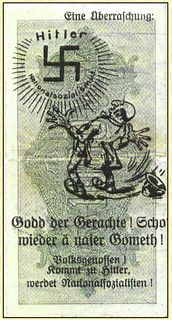 The Austrians and Germans often placed anti-Semitic symbols, caricatures or overprints on their banknotes. I wrote about this in an article
entitled “Anti-Semitism on Notgeld” in the International Banknote Society Journal, Vol. 25, No. 3, 1986, and another entitled “Anti-Semitic
Overprints on Currency” Vol. 25, No. 4, 1986. Since currency is handed from hand to hand, it is a great media for propaganda. Anyone holding one of
these banknotes could read the virulent anti-Semitic propaganda on the front or back.
The Austrians and Germans often placed anti-Semitic symbols, caricatures or overprints on their banknotes. I wrote about this in an article
entitled “Anti-Semitism on Notgeld” in the International Banknote Society Journal, Vol. 25, No. 3, 1986, and another entitled “Anti-Semitic
Overprints on Currency” Vol. 25, No. 4, 1986. Since currency is handed from hand to hand, it is a great media for propaganda. Anyone holding one of
these banknotes could read the virulent anti-Semitic propaganda on the front or back.
The leaflet above shows a caricature of a Jew being shocked and frightened by a glowing sun with a swastika at center. The text is:
A surprise: God the Righteous! Once again a new coming!
Friends! Come to Hitler and National Socialism.
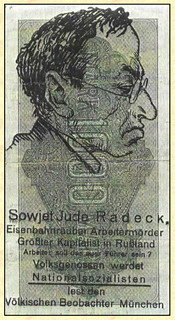 Here the Germans attack Karl Radeck. As they so often did, they insinuated that all the Communists were Jews, an interesting concept since
the Russians probably killed more Jews before WWII than the Germans did during WWII. There are several different texts, but they all have the same
general propaganda:
Here the Germans attack Karl Radeck. As they so often did, they insinuated that all the Communists were Jews, an interesting concept since
the Russians probably killed more Jews before WWII than the Germans did during WWII. There are several different texts, but they all have the same
general propaganda:
Railroad robber and murderer of workers.
The greatest capitalist in Russia. Worker: should this be your leader?
Friends, come to National Socialism. Read the People's Observer of Munich
To read the complete article, see:
ANTISEMITISM AS A PSYCHOLOGICAL WARFARE THEME
(www.psywarrior.com/AntiSemiticWWII.html)
To read the earlier E-Sylum article, see:
NEW-YORK HISTORICAL SOCIETY ANTI-SEMITISM EXHIBIT
(www.coinbooks.org/E-Sylum_v19n21a35.html)

ARTICLE HIGHLIGHTS NEW POLYMER £5 NOTES
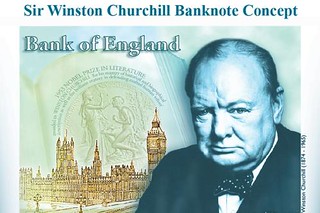 The Bank of England is not an institution normally associated with laundering money. But it will break with tradition this week with the
launch of Britain's first plastic banknotes, which can survive a 90C washing machine cycle.
The Bank of England is not an institution normally associated with laundering money. But it will break with tradition this week with the
launch of Britain's first plastic banknotes, which can survive a 90C washing machine cycle.
Unlike a traditional cotton paper banknote, the polymer version repels dirt and moisture; you can pour a glass of red wine over it and simply wipe it clean. It is also almost impossible to tear.
On Thursday the Bank will reveal the exact design of the first polymer banknote : the £5 note. The new fiver will be about 15% smaller than the current one and will feature Winston Churchill, who replaces the 19th-century prison reformer Elizabeth Fry.
About 440m of the plastic £5 notes will come into circulation in September, with other notes to follow shortly afterwards. A polymer £10 note, featuring the author Jane Austen, will enter circulation next summer and the £20 note, featuring the artist JMW Turner, will be launched by 2020.
Britain joins a list of more than 30 countries that use plastic banknotes, though it is by far the biggest economy. Australia was the first in 1988, followed by countries such as Singapore and New Zealand. The Bank has made notes from cotton paper since it was founded in 1694.
Speaking exclusively to The Sunday Times, Victoria Cleland, 46, the Bank's chief cashier, said the polymer notes had been extremely popular among members of the public who have been shown them.
“They often said, ‘Wow, that's really cool.’ You don’t often get ‘cool’ and ‘the Bank of England’ in the same sentence. They are more modern and I think they’re beautiful,” she said.
To read the complete article, see:
Plastic
fivers end era of dirty money
(www.thetimes.co.uk/article/plastic-fivers-end-era-of-dirty-money-gdnhzfgjn?shareToken=f85459b0cd39988bb23657ebd893c89c)

MAGICIAN MELTS COIN WITH HANDS
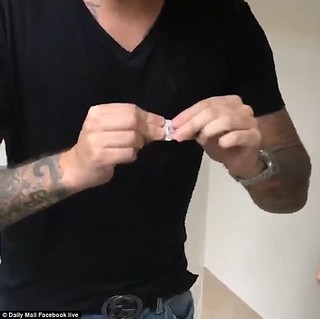 Coins are hard, strong, unbendable objects right? Wrong. A skilful magician proved to MailOnline today that he is capable of melting a 10p
coin just by rubbing it between his fingers.
Coins are hard, strong, unbendable objects right? Wrong. A skilful magician proved to MailOnline today that he is capable of melting a 10p
coin just by rubbing it between his fingers.
Damien O'Brien, 31, wowed online audiences when he appeared on the site's Facebook live and performed the trick apparently just using the heat and friction of his own hands.
Determined to prove the veracity of his magic O'Brien asks Kat from MailOnline's video team to write her initials on the coin - 'So I don't do anything sneaky,' he jokes.
The tattooed magician explains that he was 'blown away' as a child by David Blaine's trick in which he bends a coin but he wants to go one step further. 'So if I squeeze it really hard you can fell it's getting a bit warmer,' he explains as he presses it between his fingers.
The more he worries the piece of money the thinner and more extended it gets, flabbergasting Kat - and indeed the rest of the internet. Once he is finished the coin freely bends as he manipulates it and looks almost unrecognisable from the solid circle it used to be.
When laid flat it now appears to resemble a silver guitar pick it has been altered so much. 'It's a normal coin,' O'Brien insists as Kat checks his hands - which are entirely normal, if not a little red from the exertion.
There is no hint whatsoever of how he managed to achieve the mind-blowing magic trick.
To read the complete article or watch the video, see:
How did
he do that? Amazing moment a magician MELTS a 10 pence coin in mind-blowing magic trick
(www.dailymail.co.uk/news/article-3613398/How-did-Amazing-moment-magician-MELTS-10-pence-coin-mind-blowing-magic-trick.html)
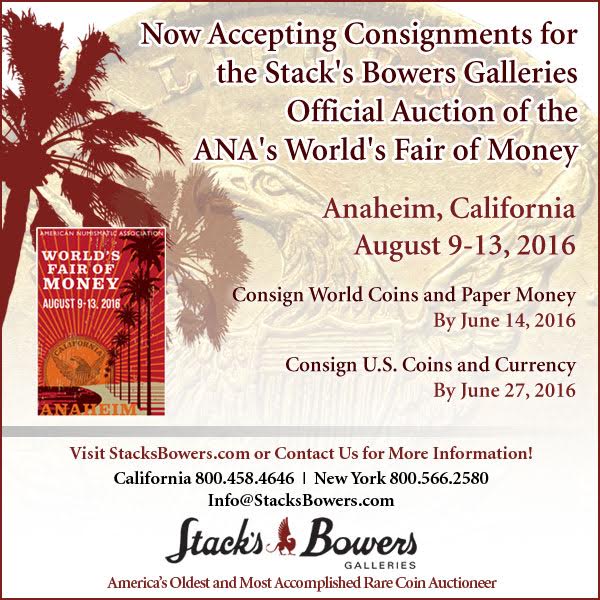
FEATURED WEB SITE: GOBRECHT DOLLARS
Suggested by Craig Sholley, this week's Featured Web Site is about pattern Gobrecht Dollars, typically cataloged by the Judd reference number. The information was compiled by Craig, John Dannreuther and Saul Teichman.To use this guide you must first determine the Judd number of the coin. This guide uses the “short” Judd numbers for identification (J60, for example). The short Judd numbers and descriptions are listed below for your reference.
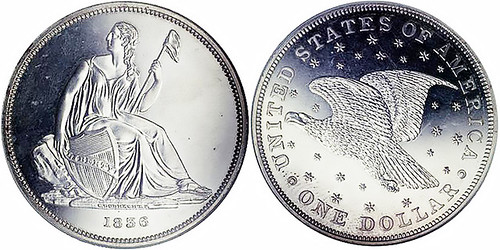
http://gobrechtdollars.com/

